#or it removes all the images that it can to prevent millions of dollars in damages
Explore tagged Tumblr posts
Text
New lawsuit has dropped to hold all AI art programs accountable for allegedly stealing art from artists. Now AI bros are coming back with: 'WELL, GUESS I WON'T BE INSPIRED EVER AGAIN!' as well as bringing up the complaint artists reference all the time and should also be held accountable.
Let me be the first to tell you: there's a difference between using royalty free images and 3D and png assets people have consented to being used for either free or a price to just ripping up someone's art piece and trying to destroy their watermark in the process without their consent.
These AI folks don't want to be held accountable, and don't want their toy to cost a lot of money or go away for good.
Artists don't want AI art to be completely shoved in the corner and destroyed. For someone like me, I can easily see it as being helpful to assist me in painting a picture in my brain I cannot otherwise envision.
But people are forgetting the: we want it to be fair and to compensate the artists it may take from.
If you don't understand that part, you're just trying to hide the fact you've always wanted to steal from artists without punishment. That you wanted 'quick and easy money' without having to pay an artist. You wanted an easy road to success. That you don't value art.
#i really hope this thing goes through the court and it wins#and that the programs have to start charging a LOT for its usages#or it removes all the images that it can to prevent millions of dollars in damages#because that's what estimated it will cost#fingers crossed#text#anti ai art
7 notes
·
View notes
Text
ughhhhhhhhh noooo stop it! aha! don’t release non-native earthworms in random plots of soil for enhancing gardens or free bait, don’t do it anywhere in North America lmaoooo! stop, it’s so dangerous and extremely harmful, with devastating and surprisingly dramatic and visible biome-wide effects! haha popular tumblr blogs should stop repeatedly and widely sharing advice recommending the release of non-native earthworms and calling it “anti-imperialist praxis” and “bioregional autonomy” and “vegan self-suffiency” lol! dooooon’t! it straight up destroys soil and outright kills forests :/ it directly causes death of understory plants; death of iconic species like goblin fern and serviceberry; elimination of vital fungal networks providing both soil structure and tree-to-tree nutrient-sharing; loss of native invertebrates and amphibians; savannification of the boundary between woodland and tallgrass prairie; death of red maple, sugar maple, and red oak stands; and especially harms hardwoods forests of the Great Lakes and Midwest lmao seriously stooooop it >:(

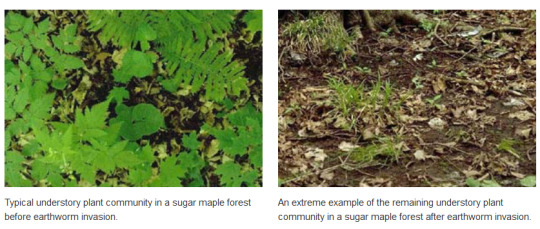



Anyway for real, I sure hope no one is deliberately releasing non-native and invasive earthworms, or bait worms, anywhere on Turtle Island/North American land, especially west of the Mississippi River or north of the Wisconsin glaciation. Earthworms and bait worms sold in stores are, by and large, not species native to the continent. They severely harm forests and soil ecology, leading directly to disruption of fungal networks; death of saplings and seedlings; death of forest understory plants; replacement of typical understory species with grasses; mortality in adult trees, as well; changes in pH; and other harm, especially devastating in northern hardwoods forests of the Great Lakes region.
Not gonna name names, but several times this year, popular blogs from the [forest-lover, anarchist/leftist/solarpunk, Moomin-fan, environmentalist-ish] realms of Tumblr have widely shared advice recommending the release of non-native earthworms or bait worms into the wild, as a form of “praxis”. I’ve got these posts screenshotted, but since I generally respect people in these circles - and in the interest of avoiding discourse and drama - I’m not going to share them. (A popular post was widely shared in February 2019; another “release store-bought earthworms” post was shared in December 2019.) I appreciate where their hearts are at. But:

Source: [x].
Some things:
From a Phys dot org summary of Great Lakes Worm Watch:
"The western Great Lakes region, which is the area we're focused on, has no native earthworms," says ecologist Cindy Hale, a research associate with the Natural Resources Research Institute at the University of Minnesota in Duluth. Native earthworms in the region were all wiped out after the last Ice Age. The current population was brought by Europeans hundreds of years ago, (soil was often used as ballast in ships) and they’re now changing the face of local forests. Anglers are adding to the problem by dumping worms that don't end up on the end of a hook.
With support from the National Science Foundation (NSF), Hale's team created the Great Lakes Worm Watch website and outreach programs to stop the spread of non-native earthworms and to clear up the common misconception that they're harmless. [...] Earthworms may be small but when they take over a forest, the impact is dramatic. They cause the rapid incorporation of organic material into the soil, changing its structure, chemistry and nutrient dynamics. What's known as the duff layer is suddenly removed, and this duff, or decaying organic material on the forest floor, is habitat for several species of insects, spiders, small vertebrates, bacteria and fungi. It is also the primary rooting zone for most plants."What's really the biggest negative effect on the plants directly is the removal of their rooting zone. It can cause mortality of adult plants but, furthermore, it can cause a loss of reproductive potential. A lot of these native plants have seeds that have very complex seed dormancy and germination strategies," says Hale.
--

Caption by Shireen Gonzaga for EarthSky: “A forest understory with a high diversity of native plants, the result when there are no earthworms in the soil. Image courtesy of Paul Ojanen.”

Caption by Shireen Gonzaga for EarthSky: “Forest soil with an abundance of non-native earthworms can result in a bare understory. Image courtesy of Scott L Loss.”
Non-native worms disrupt fungi networks, alter soil pH, damage seedlings, and allow grasses to gain stronger footholds to replace native/natural forest understory plants (from an EarthSky review of 2016 research by German Centre for Integrative Biodiversity Research):
Bottom line: European earthworms, introduced by early settlers, are changing the physical and chemical characteristics of soil in northern North American forests, creating a decreased diversity in native plants. [...] At the top soil layer, earthworms convert fallen leaves to humus. That’s a good thing if you’re growing a garden, but, in a natural forest, it causes a fast-tracking of the release of nutrients instead of allowing the leaf litter to break down more slowly, as it would without the earthworms.
Also, as they burrow through the ground, earthworms disrupt the mutually beneficial symbiotic relationship between fungi and plants. Some deep-burrowing worm species change the pH of upper soil layers by mixing in alkaline soil from deeper in the ground. [...]
All of these changes adversely affect native plants that did not evolve in such conditions. For instance, the goblin fern is rarely found in areas with high earthworm density. Other native plants facing threats include largeflower bellwort, trillium and Solomon’s seal. Earthworms also consume the seeds and seedlings of some plant species, influencing what grows in the forest understory.
In some locations, grasses, with their fine root systems that quickly absorb nutrients, dominate the forest floor. Non-native invasive plants that evolved in soils containing earthworms gain an even stronger foothold in these forests.
--
Cindy Hale, the prominent University of Minnesota-based researcher of non-native earthworms in the Great Lakes region, has published this book through Kollath-Stensaas Publishing:


--
Non-native worms harm birch trees specifically and hardwood forests generally (excerpt from University of Toronto research, 2016):
The worms can cause dramatic changes to ecosystems by altering soils, reducing leaf litter and disrupting microbial interactions, which reduces biodiversity. Now it seems they are also eating plant seeds in the wild, potentially altering the make-up of forest communities. (…)
“They eat a lot more seeds than we think,” says Cassin [ecologist at University of Toronto in Mississauga], now at the Ontario Invasive Plant Council in Canada.
The study shows another way that earthworms can alter forest ecosystems, particularly for small-seeded species such as birch, says Lee Frelich, an ecologist at the University of Minnesota in St Paul. (…)
Once earthworms have invaded a habitat, they are almost impossible to eradicate, says Erin Bayne, of the University of Alberta in Canada. Conservationists must instead work to keep worms out of pristine habitats, he says, for example by restricting the use of worms as fishing bait and by controlling accidental transport of contaminated soil.
--
Non-native worms lead to wildflower, fern, and sapling death. In hardwood forests, this loss is probably due partially to how worms degrade the duff layer; the loss of this layer also provokes soil erosion and directly eliminates the forest floor shelter of larger invertebrates and amphibians. When saplings cannot establish themselves, there is tree loss. (From Minnesota Department of Natural Resources)
Studies conducted by the University of Minnesota and forest managers show that at least seven species are invading our hardwood forests and causing the loss of tree seedlings, wildflowers, and ferns.
--
Sugar maples, important both for forests and human food production, are devastated by the worms (from several years of research by Michigan Technological University across multiple national and state forests in the Upper Great Lakes):
A new study suggests that non-native worms are eating up the forest floor, causing sugar maples to die back and perhaps harming other forest dwellers.
Sugar maples are prized as much for their valuable lumber as for their sugary sap and dazzling fall colors. In Michigan alone, they are the basis of a multi-million-dollar industry. But several years ago, foresters began noticing that the crowns of the big trees appeared unhealthy, with bare limbs and little new growth. “They were losing trees before they could harvest them.” (…)
--
Great Lakes Worm Watch has some fun links and resources:


You can download a comprehensive key that helps identify earthworm species. Available for free, via Great Lakes Worm Watch:

Text from Great Lakes Worm Watch: “Different plant species respond to earthworm invasions differently. Some native plants appear to be very sensitive, so much so, that they can rapidly disappear when earthworms invade a forest. Some examples of these plants include…”


Worm Watch: “If earthworm invasion leads to changes in the mycorrhizal community of fungi, the diversity of plants that make up the understory would be dramatically changed. Fungi are a preferred food of many earthworm species and they graze it heavily, which could dramatically impact the abundance and composition of fungi in the soil. By grazing fungi on or near plant roots, the earthworms not only can damage the roots, but they prevent the plant and fungi from forming the symbiotic relationship where mycorrhizal fungi exchange nutrients and water for carbohydrates with green plants. If the fungi can't get enough food, they will die back even further. For some of the native plants that need mycorrhizal fungi, especially when the plant is young and small, survival will be difficult if earthworms prevent this relationship from being formed.”

-
NO MUSHROOMS
19K notes
·
View notes
Text
Design Beast Review
Design Beast Review Best 6 in 1 Design,Graphics and Animation Suite For Digital Marketers

Design Beast Review : Introduction
Design Beast is the best ultimate multi purpose design solution.It has six powerful design apps features under one roof.You can attract new customers with the world class technologies.It replace multiple design apps ,expensive freelancers and save your subcription fees.Design Beast has no recurring subcriptions and monthly fees.You can use it in social media,ecommerces stores,website,local business and advertising.
Design Beast Review ; The Design Beast Brand Overview
Brand Name :: Design Beast
Product Creator :: Paul Ponna & Sid Diwar
Launch Date :: 24 August
Launch Time :: 11 AM ET.
Refund :: 30 Days Money Back Guarantee
Front End Price :: $47
Bonus :: Big Bonus
Recommendation :: Highly Recommendation
Official Website ::https://designbeast.io
Design Beast Review : Design Beast Features
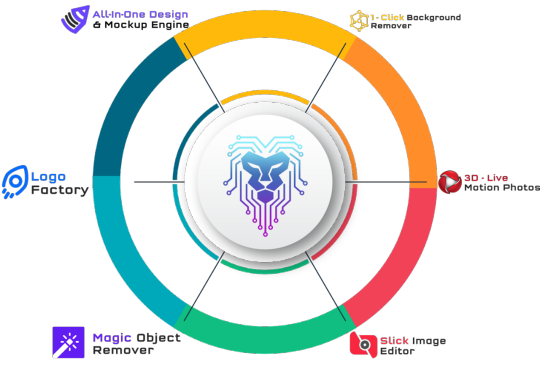
1. All in One Design & Mockup Engine
Design Beast is powerful graphics design app. It has of 7000+ ready-to-use customizable designs .
All designs perfectly sized for all the popular social platforms.
Design Beast provides Amazing T-shirt & Product Mockups, Banners, Book Covers, YouTube Thumbnails, Brochures, Certificates, Coupons, Flyers, Posters, Infographics, stunning Ads and banners for all dimensions for platforms like FaceBook, Instagram, Linkedin, Snapchat, Pinterest, Twitter and other social platforms.
You can create any other type of graphic or design you can imagine, you can create it in minutes to save time and increased your profits!
2.1 Click Background Removal
You can Easily erase backgrounds from any photos within seconds.
This Eye catching machine learning technology auto-detects the edges and objects in your photos. and automatically erases the background.
You don"t nedd to select the object manually or draw borders around the objects like other competing apps .
You just Simply upload any image into the app and let the AI do all the heavy lifting.
3.AI Logo Maker
This logo design app is Create anything you have seen before .
You can now bulk-create 50 logo variations for any brand.You just follow this 3 easy steps
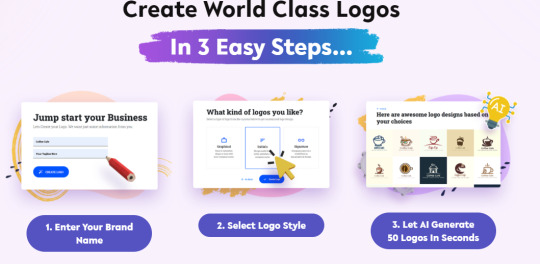
4.Best 3D Live Motion Photos
This best new animation technology lets you turn boring still photos into dynamic moving visuals.
You can add dazzling effects like snow, rain, clouds, smoke and various other motion design elements to your photos instantly.
Make your designs eyecatching to engage your audiences like never before and turn them into paying customers.
Dynamic moving visuals are proven to get up to 10 times more engagement than regular still photos.
5.Magic Object Remover
Within a few seconds this app will process the data and delete any unwanted object from your photos.
It is just like magic with unmatched flexibility for faster, superior and impressive results.
Selectively remove any objects, people or any other element you choose from your photos in 2 easy steps.
1st step :Highlight the object you want to delete
2nd step :click export.
6.It Has Slick Image Editor
Edit your photos like the professionals without used any complicated apps .
You can Edit, resize, enhance or add filters to turn blurry and unappealing photos into stunning visuals ready to print or publish online.
Please Replace multiple complicated design apps, expensive freelancers, and save thousands on subscription fees.
Design Beast Review : Who should get this app
Imagine having ALL the design, graphics and animation apps you need to elevate your business to new heights inside ONE dashboard.
DesignBeast is the ultimate multi-purpose design solution featuring SIX powerful design apps under one roof to attract new customers.
However, if you are one of the following then, DesignBeast is a must have software for the following people.
Online marketer.
Graphic designer
Animator
Social media marketer
influencer
Youtuber
video marketer
Content creator
Agency Owner
Freelancers
Website owners
Affiliate Marketer.
Design Beast Review : Design Beast Pricing & Upgrade Details
Front End : Commercial LICENSE Price $47 One-time Payment
Six Designs App For Price of One
Mockup Designer App
AI Logo Maker App
1-Click Background Removal App
Live Motion Photos App
Multi-Purpose Image Editor App
Magic Object Removal App
7000+ Ready-to-Use Templates
Millions of Royalty-Free Images
Copyright-Free Vectors & Icons
Hundreds of Fonts
Multi-Lingual Support
Step-by-Step Video Training
Commercial License
Sell The Designs For Profit
Facebook Group Access
Skype Mentorship Group Access
8 Week Training Webinar
Design Beast Personal Price :$37 One Time
6 Apps For The Price of ONE
All-in-One Mockup Designer App
AI Logo Maker App
1-Click Background Remover App
Live Motion Photos App
Slick Image Editor App
Magic Object Remover App
7000+ Ready-to-Use Templates
Millions of Royalty-Free Images
Copyright-Free Vectors & Icons
Hundreds of Fonts
Multi-Lingual Support
Step-by-Step Video Training
Personal License
Design Beast Review ; Design Beast Upgrade
DesignBeast Elite Price --- $67 One-Time
Get access to additional features worth thousands. 10X your results, sales and profits and get ahead of the competition and other DesignBeast customers.
Unlock 2,000 additional ready-to-use templates
Get 80 new templates added to your account each month for 1 year. (no monthly or yearly fees.)
Thousands of Premium Text Effects and Animations
Millions of Premium Royalty Free Design Assets, Icons and vectors.
Millions of Copyright-Free Image
Priority Future Software Updates
DesignBeast Agency Price -- $49 One-Time
Sell videos for $300 to $500 each with the done-for-you agency package included. This upgrade makes it easy for everyone to find clients and sell their designs for top dollar.
5 sub accounts
Done-For-You Agency Marketing Bundle
Done-For-You Legal Client Contracts
Done-For-You Agency Website
Done-For-You Agency Sales Video
Elite 4in1 App Bundle Price -- $39 One-Time
Pixel Perfect Instantly turn any image, even a low quality image, into ultra HD, high quality photo that can be blown up to any size - even billboard size - without any pixelation or distortion.
Animated Ads Builder
Create animated ads in all languages, shapes and sizes using hundreds of ready to use design templates. Use animated ads to promote your products, create ads for clients or sell animated designs on freelancer websites like fiverr, upwork and freelancer to maximize profits.
Video Resizer
With this powerful technology you can resize any video into multiple video sizes perfectly sized for all social platforms. Turn a single video into multiple dimensions and sizes within minutes and share the video onto different platforms to drive more traffic and sales!
Video Survey Pro
With this powerful app you can instantly collect:
* Video Testimonials
* Live video feedback from clients about your work
* Add video surveys on your websites to collect valuable information
* Have your team record video feedback about any project
Streamline your workflows without any confusion or relying on old and outdated methods like email and text.
DesignBeast Unlimited Price -- $47 One-Time
With the DesignBeast basic license you can create unlimited designs forever with one limit of 600 credits per month on each of the six apps included.
The limits reset each month so you can continue creating amazing designs, graphics and animations forever without any monthly fees.
This limit is put in place to prevent abuse and ensure all our customers are getting the best value for years to come at an unbeatable price.
As part of this special unlimited upgrade you can remove all the monthly limits and restrictions for all the cutting-edge apps and technologies included.
#design beast review#design beast demo#design beast oto#design beast bonus#design beast#graphics desiner#graphics design tool#affiliatemarketing#digital marketing
2 notes
·
View notes
Text

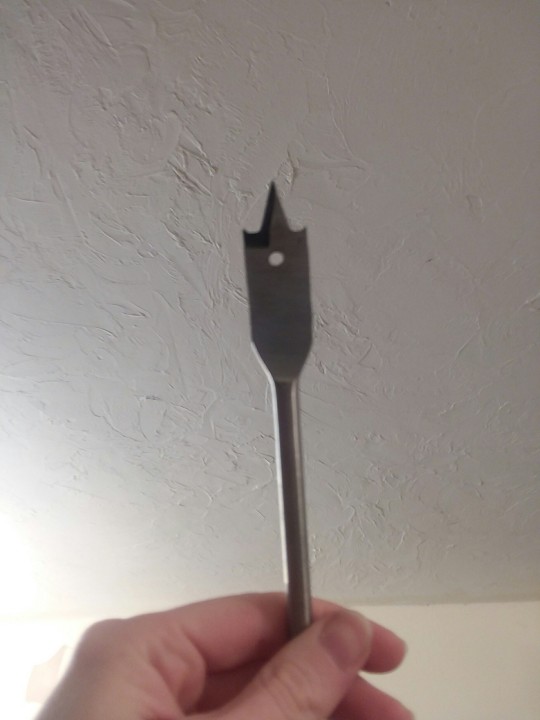


[Image description: four photos, showing first, a white hand holding up a tall and narrow black bucket like the kind you find in stores that have cut flowers in them, the second picture shows the white hand now holding up a spade bit for a drill, which is a metal piece that widens at the end before narrowing to a sharp point, and the last two pictures show first at the bottom of the bucket and the view from the top, showing the many holes that are now punched through the bottom, clustered towards the middle. End image description.]
Stabbing holes in the bottom of flower buckets to make tall plant pots for tree seedlings.
Walks works at Aldi, so she gets them for free, and you could also probably get them for free if you ask if you can take them. They get new ones in with every single shipment of cut flowers, so they have a lot.
There are also larger ones that are wider and more circular shaped while these ones are narrow, and they seem to have more of those than these skinny ones, but they're the same height, I just started working with the narrow ones so that they would be done.
We have at least a dozen right now, and that's a low estimate.
Aside from using them for flower pots when we put holes in them, we use them for water buckets that we just put in the plant room or wherever we have ceilings, just fill it with water so that we don't have to keep going back to the sink.
Also nice for melting snow in so that you don't have to use a sink at all.
For poking holes in them, we don't have any power tools, so I just use this spade bit, which I just called a stabby thing, to poke the holes in.
You could definitely use an actual drill, and some people use like, wood burning tools? But I personally would not recommend it because melting plastic can give off fumes and that's just not safe. Maybe if you did it outside with a fan pointed to blow it away from you, if you were wearing a mask, but like yeah that should be your last option.
You do not need to pay a lot of money to get this spade bit / stabby thing, you only need one of them, and you should be able to find them for like a dollar or two, don't go spending $10 on this thing, and you don't need to buy a multi-pack unless you actually plan on using all of them for their actual purposes.
Also as a related note, Aldi gives away a crap ton of free newspapers if you ask them, because they have their sales ad that they get new ones like every week, so we also get tons of free newspaper which we use as mulch in our garden to stop weeds, so that's another thing you can ask to have. The ink is 100% safe for plants.
Don't use landscape fabric. Landscape fabric is the bane of healthy soil. Instead of spending tons of money on landscape fabric that's going to do nothing but make your job harder and make your garden unhealthy, get some free newspapers and lay that down in multiple layers and then put the mulch on top of it. It will smother any little weeds that are underneath, it will prevent new weeds from reaching the soil, and it will decompose over time, adding nutrients back into your soil, and allowing the mulch to also break down, which it is supposed to do, because it adds nutrients back into your soil.
Don't buy rubber mulch. They tell you that it's not toxic, and it's true. It's not toxic to humans. It will, however, leech crap into your soil, and that whole thing where it doesn't break down? Yeah that's not a good thing. Mulch is supposed to break down. It is supposed to help your soil.
Landscape fabric doesn't actually stop weeds. They have no problem poking through it from above or below. The only thing landscape fabric does is stop insects from getting into and out of your soil, and insects are literally crucial to the health of your soil and your garden. It also means that if you ever plan on changing your garden or adding new plants or removing old ones, it is literally just going to make your job a million times more difficult than it needs to be. Do not waste your money and time on landscape fabric. It doesn't help you, it doesn't help your garden, it doesn't help the environment, it just makes everything worse.
The only thing a landscape fabric is good for is making homemade fabric pots. That's it. Get free newspaper or cardboard and use that instead.
#Rjalker trains its gardening skill#gardening#diy#gardening tips#wasnt suplksef yo be a rant bit ph well
4 notes
·
View notes
Text
What We Lost: Returning to Tumblr in 2020
On December 17th, 2018, Tumblr banned 'adult content' across the site, marking the end of an era. The ban was the result of a cavalcade of issues which reportedly made maintaining NSFW content unfeasible for Tumblr. Now, it's 2020. I'm back on Tumblr, and I can't help but meditate on what we've lost both on Tumblr, and across the globe in 2020.
Part One: Tumblr and Adult Content
*Things we lost to the flame Things we'll never see again All that we've amassed Sits before us, shattered into ash
— Bastille, "Things We Lost In The Fire"*
A bit of personal history: Tumblr was the primary community I used in various forms from 2012 onwards, associating with various fandoms, doing what I could to design interesting things. The various communities I was involved in intersected with social justice communities, and eventually I dug into those further and tried to learn to better myself in the process, starting along the path to becoming the person I did.
Part of that process was also learning to love my own body, a thing I was not particularly good at and still struggle a bit with nowadays. One of the ways I did this was by making 'adult content', or more plainly, pornography. It was a unique opportunity to experiment with femininity and sexuality - something I'd been very closed off from as part of my upbringing - in a supportive, fun environment. Experimenting with my self image first in this way, in semi-private, led to me experimenting more publicly and eventually embracing aspects of that as part of my day to day life. That's right: making pornography was part of what led me down the path to figuring out I was trans and embracing that part of me.
Making porn on Tumblr was a great time; the adult content creators and consumers community on the site was largely supportive of queer people and sexuality, different body types, all manner of things. It was - in my experience - a healthy and fun place to be, and certainly one of the better places you could be on the internet for a visual medium like pornography. Tumblr's format made it easy to share both adult content you made yourself, and stuff you were curating. Vex Ashley wrote that "this sharing was so desperately vital for women and other marginalised people whose sexualities are often overlooked or infantilised in media about sex in preference for the tastes of the traditional porn consumer – the straight white guy" in a eulogy and love letter to Tumblr's adult content communities.
Tumblr's format remains novel to my knowledge as well: the notion of having a large image-focused feed which also allows for easy sharing and curation, gorgeous, high resolution pieces and photos to be uploaded with relatively little compression, custom arrangements of photosets, and personalized theming of your blog. There was, and remains, lots of potential for expression on Tumblr., and its focus remains unique. Twitter and Mastodon's focus is on what's written, Wordpress doesn't have the sort of interlinking of blogs that Tumblr does, and Facebook is... Facebook (read: evil).
I think the novelty of that format is what made the announcement of the ban on 'adult content' so impactful. Even looking back at the framing of it is gross: the post posits that 'adult content' is something which is negative, and says that removing it is working towards a 'more positive' Tumblr. There appears to be an attempt to try and strike a balance in allowing conversation about sexuality and such, but this is the killing blow. A huge portion of the community, including countless queer and furry artists, needed to find a new home online.
3 months after the ban had hit, traffic had reportedly dropped off 20%. Recent data from SimilarWeb, the outfit which published that initial data, shows that visits to the site have dropped off a little bit more, but have stayed otherwise pretty consistent. August 2020's data shows about 317 million visits. [1] In other words: any hope that this move would allow Tumblr was dashed. A massive portion of the userbase deleted their accounts after archiving them; Tumblr and the internet at large had lost a massive, vibrant chunk of community, and it was completely in vain.
I lost contact with a bunch of those folks I was following on Tumblr for years. The mass exodus left both people who wanted to find and share artwork and adult content and the people who made it completely adrift. Years later, some artists are still picking up the pieces. Archaic policy like SESTA/FOSTA being brought into the picture has left very few standing when it comes to adult content, Twitter included. Who knows how long that will last? If something happens to change the way that Twitter handles adult content, for example, what options do casual creators like myself have?
Fortunately, platforms like OnlyFans exist. But even those are at potential risk from legislation like the EARN IT Act, not to mention the danger this poses to Twitter and to the internet at large. OnlyFans and its ilk, as they exist right now, are fantastic for sex workers because they offer pay-gating and a variety of features to make sure sex workers get paid. But they leave those of us who want to be able to curate the content they enjoy or casually create their own content freely without real options, and without real community.
We stand to lose a lot, and as always people in the margins will be the ones most impacted: the queer, the people of color, the disabled; all will suffer greatly if adult content is found without a home. Media dealing with queer themes is enough to be considered "adult content" by some and it's not hard to imagine what we could be staring down the barrel of here.
What have we lost in eliminating platforms like this?
Part Two: 2020 and the World
*These are the things The things we lost The things we lost in the fire, fire, fire.
— Bastille, "Things We Lost In The Fire"*
Meditating on what we have lost seems to be a running theme for the year 2020.
January: New Year's Day. In Aotearoa New Zealand, smoke covers the skies from a fire a literal ocean away. The Australian bush has been on fire, part of one of the most and it has turned the skies of a nation not it's own orange at midday, across thousands of kilometers. What did we lose in those fires? What stories and history? What wildlife, what species? What will remain afterwards? What will grow anew?
April: Aotearoa New Zealand hits the peak of COVID-19 related lockdown with the entire nation moved to Level 4, meaning that nothing except truly essential services, such as roadworks, pharmacies, and supermarkets were open. During that time, I thought a lot about how some of my favorite small shops were doing; the bakery with astonishingly good pies, the charming dollar store which always has a few things that catch my eye, the coffee cart near one of the local parks every morning. As a nation, Aotearoa acted early to deal with COVID-19 with a strong hand, and it was risky for all of those small shops across the country. What would we come out the other side of the lockdowns having lost, both in terms of human cost and cost to the places around us?
May: Following the murder of George Floyd at the hands of Minneapolis Police officer Derek Chauvin, massive protests against police brutality, racism, and white supremacy break out across the United States of America. Daily protests have continued to the time of writing in some cities. George Floyd is one of 781 people killed by police in 2020 at the time of writing in the United States alone [2]. 1099 people were killed by police in 2019 [3]. What incredible lives and stories have been lost in the process? Are those stories being told now? How do we prevent this from happening again? (Hint: defunding the police will be a start, and supporting the cause now is a good choice too.)
It is now September: The incompetence of the US Government has allowed COVID-19 to spread beyond control, leaving tens of thousands of deaths in its wake; lives and stories which must be remembered and their stories carried on by others. The western coast of the United States is on fire, blanketed in smoke and ashes. Massive west coast cities like San Francisco gain an apocalyptic feeling as the skies turn orange, like they did for me in January. Friends of friends lose everything in small Oregon towns. The costs of the prolonged fires will be paid by people all up the coast; it's their health outcomes which will suffer. What will we lose as a result of this in the future? What can we do to make things better?
I want to be clear: this is not a comprehensive list, and is centered around the things that me and my social circles have been aware of and talked about. Even with that consideration, we have to reckon with massive, ongoing, and far reaching concerns. The loss felt as a result of all of the above issues is staggering, and far reaching, and we must fight to ensure that loss is not in vain. Voting alone is not going to solve these concerns, and there's more to concern yourself with than any one person should have to cope with. There's not a magic bullet to solve all this stuff though.
Rather than pretend that I have one, I want to propose a couple things to close this out: one bit of advice, and one plea for yourself and others.
The advice: pick your battles carefully. Pick issues you want to focus in on, and fight for those things to make things better where you live, and in your social circles. Choose things to care deeply about first. Keep caring about them.
The plea: think carefully about the questions I've asked throughout this piece, and think about the things in your life and communities that you have lost. Think about how to make sure those losses are taken with you and learned from; to take lessons learned and better yourself and the people around you. Think about the things you don't want to lose, and how to fight like hell for them.
Move forwards to something, and some place better than where we are now. Stand united with the people around you, and press on.
*Do you understand that we will never be the same again? The future's in our hands and we will never be the same again.
— Bastille, "Things We Lost In The Fire"*
If you enjoyed this piece and want to support my work, please contribute to my Ko-fi. If you are interested in re-publishing this piece on another site, please contact me either here or via my business email.
References
[1] Data provided by SimilarWeb; accessed on 15/09/2019 at 5:30am. (https://www.similarweb.com/website/tumblr.com/)
[2] Data provided by Mapping Police Violence (https://mappingpoliceviolence.com); accessed on 15/09/2020 at 4:08am NZT
[3] Data provided by Mapping Police Violence's (https://mappingpoliceviolence.com) database, downloaded on 15/09/2020 at 4:08am NZT. Count obtained using the following formula:
=COUNTIFS($'2013-2020 Police Killings'.F:F,">=1/1/2019",$'2013-2020 Police Killings'.F:F,"<1/1/2020")
17 notes
·
View notes
Text
Read This if You’re Curious About The Results Of The War On Drugs

Have you ever wondered where America’s-for lack of better terms-obsession with drugs came from? If not, have you at least become curious as to why the American government felt the sudden need to tirelessly advocate against drug use? The vast world wide web presents endless information on the nation’s War on Drugs; including how it came about, the effects it has had on our country, and where we are now. Yet, many of these website’s explain this information through wordy articles that are sometimes difficult to follow or simply downright boring. Chelsey Chats presents to all willing readers the ins and outs concerning the War on Drugs, it’s ramifications, and what this information means, in simple terms. Let us begin.
Drugs have not always been viewed as harmful, taboo, and negatively life altering. Countless individual cultures have utilized various types of drugs for pharmaceutical and religious reasons. Recovery.org found The Native American Church to be one of the most well known religions which use drugs to exercise their faith. The Native American Church uses a highly potent drug called peyote in certain ceremonies. An additional common religion that utilizes drugs for spiritual purposes is Hinduism, which has traditionally used cannabis to worship. Drug Policy Alliance asked the million dollar question begging to be answered in an article titled “A Brief History of the Drug War,”: why are some drugs legal while other drugs are prohibited? To provide readers with all-inclusive understanding, we must first understand the origin of the infamous War on Drugs.

In the 1960’s, around the time when bell-bottoms, lava lamps, and go-go boots were at their prime, drugs had become what Drug Policy Alliance calls, “...a symbol of youthful rebellion, social upheaval, and political dissent.” As drugs became increasingly frowned upon by parents and political figures, the American government was obligated to counter this “growing threat”. The first president to do so was former President Nixon; in June of 1971, Nixon officially declared what he called a “War on Drugs.” President Nixon swiftly took action by mandating a handful of new orders and policies. These orders included significantly expanding federal drug control bureaus, and administering policies such as the notorious mandatory sentencing. Nixon also strategically placed cannabis in Schedule One; this distinct classification of drug categorizes cannabis as high potential for abuse.
The year following Nixon’s series of changes, the commission recommended reversing Nixon’s decision to place cannabis in Schedule One. Instead, the commission held that the drug should be decriminalized for the possession and distribution of cannabis for personal use. This suggestion was entirely ignored by Nixon. This information leads us to revisit the initial question presented by Drug Policy Alliance; why are some drugs perfectly legal while others are strictly and heavily prohibited? Writers for Drug Policy Alliance summed it up perfectly, “It’s not based on any scientific assessment of the relevant risks of these drugs- but it has everything to do with who is associated with these drugs.”

The War on Drugs did not end with Nixon’s presidency, in fact, quite the opposite. Former President Ronald Reagan took office in 1981, where he chose to continue to carry out the plans of his predecessor. The first lady, Nancy Reagan, launched her own anti-drug campaign in which she created her well-known slogan, “Just Say No.” Mass hysteria surrounding the subject of illegal drug use was partly owed to the media, which consistently presented images and news of American citizens addicted to the free-base form of cocaine called “crack”. Nancy Reagan’s campaign pushed for “zero tolerance” programs which showed no mercy to individuals who had fallen victim to the highly addictive drug.

The rise of the war on drugs continued to increase. Los Angeles Police Department Daryl Gates established the renowned project D.A.R.E, which educated youth on drugs. Drug Policy Alliance stated that the program “... was quickly adopted nationwide despite the lack of evidence and effectiveness.” The result of the mass hysteria concerning drugs in our communities began to shift the way American’s perceived drugs. In the year of 1985, the amount of American citizens who thought drug abuse was the country's most important issue was estimated to be about two to six percent. Around four years later, the percent of Americans who thought drug abuse was the most crucial issue jumped to an astounding 64%. Congress viciously fed off the American hysteria, placing severely harsh penalties concerning drug use, trade, and distribution. Long after the hysteria subsided, the harsh penalties remained.
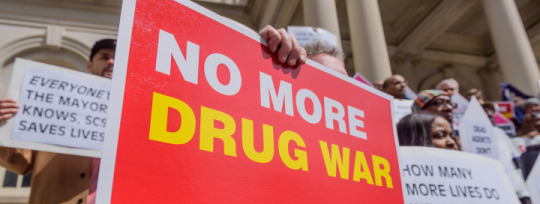
The War on Drugs was composed of anti-drug programs, excessively harsh laws, expansions of federal drug control agencies, doubling prison populations and endless anti-drug marketing. The War on Drugs founded by Nixon had lasted almost 50 years. After 50 years of advocating against drug use, the results are disheartening, to say the least. The Penal Reform Institution stated, “The enforcement of overly punitive laws for drug offenses has not only proven to be ineffective in curbing production, trafficking, and consumption of illicit substances, but had many negative consequences including overloading criminal justice systems, overwhelming courts, fueling prison overcrowding, and exasperating health problems.”

There were many faults to the War on Drugs project from its very inception. To begin, the prime reasoning behind the project’s launch stemmed from ill and discriminatory intentions. Nixon’s former domestic policy advisor, John Enrichman, later revealed Nixon’s hidden agenda in starting the War on Drugs. “The Nixon campaign in 1968, and the Nixon White House after that, had two enemies: the antiwar left and black people. You understand what I’m saying? We knew we couldn’t make it illegal to be either against the war or black, but by getting the public to associate the hippies with marijuana and blacks with heroin, and then criminalizing both heavily, we could disrupt those communities. We could arrest their leaders, raid their homes, break up their meetings, and vilify them night after night on the evening news. Did we know we were lying about the drugs? Of course we did.” You can find out more here.
The War on Drugs primarily focused on low-level offenders and drug users. This moved the government’s focus from removing actual offenders of organized crime. The project also failed to sentence drug users and dealers accordingly; there was minimal distinction between the possession of illegal drugs and trafficking. The War on Drugs project also provided an unfair disparity between crack and cocaine sentences. Penal Reform International concluded that the “...biggest contributing factors in the startling increase in incarceration in the U.S. is traceable to the arrest and imprisonment of poor people of color for non-violent and drug related offenses.”

Now that we’ve drawn an adequate illustration of the War on Drugs and its efficiency, this post will present some useful statistics to provide readers with full understanding. Writer for The Globe, David Case, wrote a commendable article titled “The War on Drugs: What Is It Good For?” which broke down the various aspects of the campaign and analyzed the results. From gathered statistics, Case estimated that the 50 year long war on drugs has cost the nation a whopping $2 trillion dollars, and calls the war “nearly still born.” As of 2013, almost 3 million people are incarcerated; equivalent to more than 1 in 5 of the planet’s prisoners. To provide readers with a better understanding of what this means, Case provided that the number of American inmates currently serving time for drug related charges surpassed the total U.S. prison population in the year of 1970.
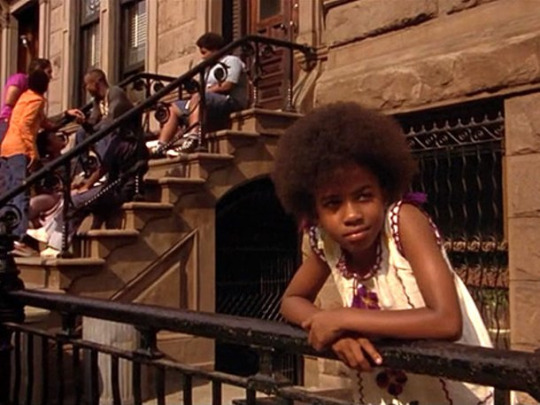
The effects of the War on Drugs project caused a negative trickle-down effect that affected American neighborhoods, families, and taxpayers across the country. The World found, “Illicit trade has transformed neighborhoods- from Baltimore to Detroit to East L.A.- into battle zones where innocent citizens live in fear of violence and shady dealers.”
Not only this, the plans specifically designed to fuel the War on Drugs has proven to have failed or backfired. The project has not considerably affected the overall flow of drugs in America. In fact, the prohibition of drugs has consequently amplified the worldwide black market, which has been estimated to worth a whopping $300 million.
Furthermore, the War on Drugs has been identified as the leading cause behind the spike in crime. Jefferey A. Miron, A Harvard lecturer, explained how the outlawing of drugs ultimately forced the drug industry to move underground. Inevitably, this meant that sellers and buyers were unable to settle any possible disputes with legal action, leaving the individuals to rely on violence. Miron further conducted a study back in 2010 which concluded that full legalization of drugs in America has the potential to save taxpayers over $40 billion dollars each year. Taxing these drugs was also estimated to bring in over $40 billion dollars in revenue, meaning changing our drug policies could yield over $80 billion dollars in revenue each year.
The primary fuel behind the War on Drugs was to prevent drugs from invading our communities, and more specifically, harming our youth. Yet unfortunately, the project failed to keep the youth from obtaining and using drugs. A study conducted in 1975 found that approximately 40% of high school seniors across the nation reported having smoked cannabis in the past year. By the year 2012, the rate had dropped by a mere 4%, as around 36% of high school seniors reported that they had smoked cannabis within the past year.

Now that readers have a thorough understanding of the War on Drugs and its effects, which have appeared to be completely negative, I would love to present some of the positive effects the project has had on the nation. I sifted through an endless amount of websites searching for positive outcomes of the War on Drugs. Nonetheless, I failed to find any positive outcomes that could be scientifically/evidently supported. Counterpunch.org provided one of the funniest positive outcomes claiming, “Via programs like DARE, it has turned kids into drug informants who monitor their parents for the authorities.”
“The global war on drugs has failed, with devastating consequences for individuals and societies around the world,” concluded a June 2011 report published by the Global Commission on Drug Policy. The report noted that between 1998 and 2008, global consumption of opiates had increased 35%, cocaine 27%, and cannabis 8.5%.” -The Globe

So… what does this mean? Well, this means it's time to reverse the damage that has been done. It means it's time to restore our communities, amend drug policies, exonerated individuals who have fallen victim to these severe drug policies, and restore families. Public opinion has begun to substantially shift in favor of logical reforms that support health-based approaches to combating drug use.
Good news; the change has already begun. States across the country have already taken the first step by participating in marijuana reform. Many states have decriminalized cannabis, while others have legalized it all together. America has continued to take progressive steps; dozens of states have passed legislation in order to increase access to the overdose antidote, naloxone, in efforts to fight the overdose epidemic. Drug Policy Alliance has compelled the government to support drug policy reforms, and has successfully brought about major change. On November 3, 2020, the state of Oregon passed Measure 110, becoming the first state in American history to decriminalize all drugs. This created a significant shift in American support in favor of treating addiction with a health based approach rather than a punitive approach.
There you have it Chatters. This blog post has provided you with the full history of the War on Drugs (sparing you the painful details), with supportive evidence, a birds-eye view of where we are today, and what all of this information means. Personally, I’ve always found the War on Drugs and its effects especially intriguing. Therefore, I hope you enjoyed this blog post half as much as I enjoyed creating it for you. That brings us to our final quote:
“There's a phrase, "the elephant in the living room", which purports to describe what it's like to live with a drug addict, an alcoholic, an abuser. People outside such relationships will sometimes ask, "How could you let such a business go on for so many years? Didn't you see the elephant in the living room?" And it's so hard for anyone living in a more normal situation to understand the answer that comes closest to the truth; "I'm sorry, but it was there when I moved in. I didn't know it was an elephant; I thought it was part of the furniture." There comes an aha-moment for some folks - the lucky ones - when they suddenly recognize the difference.” -Stephen King
Until next time,
Chelsey Chats.
3 notes
·
View notes
Note
You said you could infodump on Okinawa? Could you tell me more about Okinawa? I know some basic stuff (independent Ryukyuan kingdom effectively until late 1800s, culturally distinct, Hawai'i : USA : : Okinawa : Japan, lot of American bases creating tension since WWII, kinda thing), but I'd love to know more.
Oh Omi, I am so late with this response, but I’m so excited to talk about Okinawa!!!
(It’s so funny, I’m actually currently associated with an organization called the Okinawa Memories Initiative (OMI) for short, so this has been a funny little joke for my sleep-deprived mind.)
So, Okinawan history is really long and complicated, as all good histories are, so I guess I’ll start with the idea that even though Okinawa is not formally and officially considered a place where indigenous people live, that is absolutely the case! Okinawa has close to about 800 separate dialects across the archipelago chain, and those have been classified into 6 completely distinct languages by linguists and language preservationists. Okinawan clothes, religion, customs, food and environment are very very distinct from mainland Japanese customs, and actually, Okinawan customs mirror the only indigenous group that Japan does recognize, the Ainu, more than it ever looks like mainland Japan.
Despite all of that, Okinawan people are not recognized as an indigenous group officially, and that’s solely because of the American presence on the island. The base situation on Okinawa would be illegal by the UN conventions, were Okinawa considered to be an indigenous population, so bureaucratically, Okinawans are not considered indigenous peoples. Many Okinawans themselves have debates about this: some people wish to be recognized as distinct from Japanese, but the vast majority of Okinawans think of themselves as Japanese and part of Japan, and although they have a different culture, they see it in the same way that Osaka or Hiroshima has slightly different customs from Tokyo. And even those who consider themselves to be distinct from mainland Japanese folks don’t necessarily like the term “indigenous” very much either!
The base issue on-island today is very heated because these issues actually stem back much longer than just the American occupation. The idea of Okinawan indigeneity is long and tumultuous.

But, let’s take a small detour: Why are the Americans on the island still? That’s a good question. After WW2 and the historically bloody Battle of Okinawa, the Americans took over Okinawa, hoping to use it as a place to launch a mainland attack on Japan, before the idea of atomic bombs were publicized. After the atomic bombs, however, the U.S was very confused about what to do with Okinawa, for a period of about 4 years. They figured they would do to Okinawa what they did to Japan: set the island up to be economically stable, maybe economically dependent on the U.S, and just leave. They didn’t see much to be gained from Okinawa: it’s pretty barren and not super fertile for growing crops, not like the Philippines was. Then, in 1949, the Chinese Communist Party won the Chinese Civil War, and the U.S decided that no, actually, they weren’t going to leave.

This is a map of Okinawa. It’s a military strategy map, and it’s one of the reasons America calls Okinawa, “The Keystone of the Pacific” -- in the midst of Cold War Era preparations, the holding of Okinawa became crucial as a part of America’s Communist Containment Strategy against North Korea and China and Vietnam.
The U.S. was like, “Psyche! If any of you start a war or get too cocky, we’ll be there within the hour to send troops down, so. Don’t do that! This is a deterrent strategy :)”
The Okinawans, of course, replied back, “Hey. If you’re close enough to China to drop a bomb on them within the hour, aren’t they close enough to us to drop a bomb on us within the hour?”
And the U.S said, “Don’t worry about it :) Your lives aren’t important enough.” This is where a lot of the anger, fear and frustration about the American presence on Okinawa comes from, the fear that Okinawa could get nuked or bombed, in a Pearl Harbour strategy to get rid of America’s major firepower, a process that would harm Okinawans who don’t feel they’re involved or interested in any of America or Japan’s major fights with the rest of the world.
During the Cold War, Okinawa was used as the launch point for troops headed to the Korean War, the Vietnam War, and even the Afghanistan War. And Okinawans, on their own island, were treated like secondary citizens by the U.S Military Provisional Government. One of the biggest archival records of the injustices that the U.S government inflicted upon Okinawans is the land seizure and underpayment of money for the land seizure, documented and detailed by the U.S provisional government from the 1950s-1960s. By the U.S Government’s own admission, they cheated Okinawans out of millions and millions of dollars, by seizing their land, preventing their crop growth, and underpaying them for the value of the land: and this isn’t even taking into account the significance of the US government stealing ancestral lands, and building bases over and around big ancestral tombs on Okinawa, and barring people access from those tombs.

(This is an image of a golf course onbase, that just has an ancestral tomb there. You can’t get onto base without a U.S passport, and Okinawans have a festival called Obon, which is very similar to Toussaint and Day of the Dead, where you go to your ancestral tombs and clean it up/pay your respects. This is now impossible for this particular family)
Okinawa is the poorest prefecture in Japan, and although it’s certainly because of pre-war discrimination and the destruction of pretty much all Okinawan capital during the war, the post-war suppression of Okinawan wealth, through the U.S. Military Government’s extortion plays a huge role
There was a large protest movement, headed by a man called Ahagon Shoko, against the U.S Base presence, specifically centred around the issues of land seizure and land rights. Another concurrent movement, started by more liberal, anti-war Okinawans, was centred on removing the U.S base presence because of the threats faced by Okinawans during the Cold War. A third movement, filled with people who felt more closely aligned with Japanese nationalists, and were fed up of the strange, new customs that the American government was imposing upon the populace, pushed for Okinawa to return to Japan. These movements all put a lot of pressure on the U.S Military government, and eventually led to the 1972 Reversion of Okinawa from American control to Japanese control.
This wasn’t the happiest solution. After all, during the war, Japan’s fascistic treatment of Okinawans as expendable soldiers who have to give up everything for the Emperor—but also, your language and customs are backwards and we think you’re inherently untrustworthy—was something most Okinawans despised. Going back to Japan was not an ideal solution for many who felt humiliated by mainland Japanese folks.
However. Even though the island was now part of Japan, the U.S bases never left. A few were shut down, but the majority of the large bases remained. This was, in many ways, a problem.
Some statistics (which are highly contested, so take them with a grain of salt!) 75% of the American bases in Japan are congregated on Okinawa, taking up over 35% of the available land on Okinawa. Of the land that has been paved over by the American bases, about 65% is supposed to be arable, fertile land. For what the American bases primarily do, which is working with experimental technology and running field training, the American bases are FAR too close to cities and places where people live, especially in a town called Ginowan.

This is just a screenshot of Google Maps around MCAS Futenma, and you can see just how closely the base hugs the town. What you can also see is the proximity of several schools and universities to the edge of the base, which has been the cause for many tragic accidents. Okinawa International University's incident with the Osprey crashing into one of the buildings, and injuring several students, is perhaps the most well-known issue, but just last year, a helicopter window fell out of a test vehicle, and landed on the elementary school playground, which only just narrowly avoided killing students.
The daily noise pollution is more of a problem, though. One of my friends, is actually in the process of writing a research paper, with an ARC GIS map describing the levels of noise pollution in the cities around bases. It’s not published yet, so I don’t have the images for you, but ALL of the bases violate international laws about noise pollution that’s acceptable for civilians to be exposed to. It’s pretty bad.
So, there’s been a movement to get rid of the bases on Okinawa lately, and in some ways, it succeeded. The U.S government has agreed to eventually get rid of MCAS Futenma. Bill Clinton signed a bill in 1992 saying it would eventually be removed.
However, the military is constantly infighting, there’s a big pissing competition between the Army, Marines and the Air Force, and the Marines were not happy with the idea that their influence on Okinawa would be reduced (MCAS Futenma is one of the biggest Marine bases on-island.) So instead, they decide to expand their base at Camp Schwab, which is up in the north of Okinawa, in a place called Henoko.

(This is a picture of Camp Schwab and Oura Bay: all of the marked-out land has been filled in with concrete by this point.)
You’ve probably heard of Henoko in the news a lot, its construction is a huge controversy. Henoko is special for a multitude of reasons. Not only is it a spiritual place for many of the Okinawans there, it’s also home to one of the largest coral reefs in Japan AND it’s the home of the endangered species, the dugong. To build out Henoko, they would have to destroy the coral reef by filling in the bay with concrete, and they would have to destroy a lot of the natural wildlife on land and in the ocean. Understandably, Okinawans and wildlife activists alike were NOT pleased.
Activists set up a large protest tent outside Camp Schwab, and have been there since the 1990s, when the Henoko construction was first announced. The main protestors there are old folks, and although the news loves to pretend that the base issue is only a thing that old people care about, that’s just not the case. Younger people have jobs and school and can’t be there, but the mood of the populace is very much against new bases being built!
(On a sidenote, a lot of young folks don’t mind the existing bases being around, actually, but it’s a complicated and nuanced topic, especially when we discuss young women. For more details, I would suggest the INCREDIBLE book by Akemi Johnson, Night in the American Village, which details the ways in which Okinawan women interface with American troops in positive and intensely negative ways. The American military gets extremely bad press in Okinawa for the frequent rapes, and violent incidents that occur every couple years like clockwork.)

(I was actually at this protest, which happened in 2018, after the death of beloved Okinawan Governor, Takeshi Onaga, who was a staunch anti-military-base politician. Thousands of people were gathered together on this incredibly rainy and miserable day, that precluded a typhoon, just to voice their support against the bases. It was truly a moment of understanding just how deeply he base issue rings in the hearts of many, even if they can’t afford to express it all the time.)
Anyway, after a lot of back-and-forths, and issues with Henoko constantly being brought to the appeals court in San Francisco and dismissed by the U.S. Government, the issue comes to a head in 2019. New governor, Denny Tamaki, is appointed as the successor to Takeshi Onaga, and he’s very anti-base as well! In fact, one of the first things he does, is hold a referendum, to gauge the Okinawan mood against Henoko’s construction. What’s the outcome?
youtube
Absolutely unsurprising for anybody who’d been paying attention. More than 70% of Okinawans are against the bases. Does this stop the American construction in any way? Nope! In fact, just three days after the referendum results were released, the bay was completely filled in with concrete and the coral reef was destroyed.
You might be wondering at this point: why does Japan tolerate the presence of the American military in what is actually a Japanese prefecture? Well, simply put, the Japanese-American alliance is incredibly strong at this point, and is almost entirely from self-preservation. In the Japanese constitution created by Americans in the aftermath of WW2, racist Americans thought that the Japanese people were simply “predisposed towards war” and the only way to prevent Japan’s imperialism was to prevent them from being militaristic all together. Article Nine of the Japanese Constitution bans Japan from having a standing army. Japan doesn’t really obey this. The Japan Self Defense Force is actually the fifth largest army in the world in terms of firepower: with the caveat that they can’t start conflicts, they can only defend themselves and aid their allies. So, America and Japan are deeply tied together, because America could potentially start wars Japan can’t, and help defend them, in the event of a war.
Japan, as I mentioned before, also still has something of a discriminatory attitude toward Okinawans. Pretty every depiction of Okinawans I’ve seen in Japanese popular media is filled with hurtful stereotypes and is pretty xenophobic? And many Okinawans describe going to mainland Japan as something very strange, because there’s this common perception that they’re uneducated hicks or whatever. Okinawans still aren’t really considered Japanese, and so there’s very much a NIMBY attitude about the military bases by the Japanese government. They essentially think, “Well, the American bases are a necessary evil to keeping Japan safe. Oh, and most of them are congregated in Okinawa, where the average Japanese citizen won’t ever see them? Great!”
(Not to mention, a few of the big bases on Okinawa are JSDF bases and are equally despised by Okinawans too, and there’s an understanding of why the Japanese government is fine with American interference, and refuses to allow Okinawan opinion to sway their minds).
Although construction had been halted onsite for a while, because of coronavirus, it’s back to building as usual, despite the ongoing protests at Henoko. I don’t think the Okinawan people win this battle against the will of the American government, destroying things all over the world, as they are wont to do.
In one final piece of tragedy, the last Okinawan dugong has been missing for the past few months, after the other two were found dead. We think it’s almost certainly dead too. The dugongs, who are spiritual vessels in the Okinawan religion, are a true loss.
In terms of Okinawan language and culture and stuff, I think I might need another post entirely to discuss that, but some incredibly special and incredible parts is:
Okinawan Music, usually sung in uchinaaguchi! Both more traditional songs like Tinsagu no Hana (remixed here by some cool folks!) and some newer songs by BEGIN like Nada Sou Sou and Shimanchu nu Takara! Just some incredibly moving stuff.
One of the many folk dances on Okinawa, Eisa! Eisa’s usually performed during the Obon season and it’s such a beautiful and skilled dance coordinated by so many! One of the most fun things during Eisa season is every year, 10,000 Eisa dancers fill up International Street in Naha and dance pretty much all day! Here’s a video of the festival that I went to (but not my video, since I didn’t have a tripod that day)
The UNESCO page and its justifications for why it chose certain Okinawan sites is a good useful place to start, when thinking of unique Okinawan architecture! From the red-brick roof tiles of Shuri Castle (which was tragically destroyed in a fire in late 2019), to the unique constructions of all the old gusuku, made without mortar, to the beautiful Seifa Utaki, where many practitioners of Okinawan religion gather for its spiritual connections, there’s a lot to learn!
Okinawan pottery is absolutely gorgeous! One of the main recognized styles is tsuboya-yaki, which was created in the Ryukyuan Dynasty in the 1400-1500s, but refined by Kinjo Jiro, a man so good at redefining Okinawan Pottery, he was called a Living Treasure! All pottery in Okinawa used to be centred around the Tsuboya district in Naha, but when Kinjo moved up to Yomitan, some many people followed him that Yomitan is now a pottery destination! There are other styles too, influenced by China and Korea.
I could keep going. Okinawa’s known for all of its folk-crafts. From bingata, to lacquerware, to kijoka-bashofu, to ryukyu glass...there’s an incredibly vibrant and alive culture, for all that people want to pretend Okinawan cultures are dead and in the past.
I wrote my undergraduate thesis on the way that Okinawan culture is both dependent on the sorts of tourism that keeps a lot of these folk-crafts and traditional sites relevant and funded, but are also destroyed by the ways that tourists bring their own colonialist visions to Okinawa and how Japan’s influence in Okinawan tourist sites keeps alive imperialist narratives about Okinawa, and how tourist presence often destroys the natural beauty of a lot of these sites. It’s a constant difficult survival of balancing the two, but it’s not an unfamiliar struggle for anybody who studies indigenous island cultures and the way that tourism works in those places. In any case, thinking about Okinawan culture in a non-touristy sense is the best thing to do!
11 notes
·
View notes
Photo



The Emerald Ash Borer: Destruction in North American Forests
The emerald ash borer (Agrilus planipennis) (EAB) is a relatively new invasive species to North America. It is thought to have been first introduced and established in Michigan around 1997, though it was not discovered until June of 2002. The EAB is a relatively minuscule insect, only measuring 7.5-13.5mm long, and slender bodied. It ranges in colour from green to bronze, with emerald wing covers, and a metallic red-purple abdomen under the wings. The larvae are white/cream coloured, are around 26-32mm long, and have segmented bodies.<!-- more --.
The EAB originates from Asia, most commonly found around the Eastern coast. The emerald ash borer has spread quickly throughout North America, wreaking havoc on the ash trees (Fraxinus spp.) in more than half of American states (see map image) and 2 Canadian provinces, Ontario and Quebec. With the very quick spread of EAB, knowledge on their life strategy is an asset in helping prevent further damage. With 150-200 million trees already deceased, the emerald ash borer is costing the US approximately one billion dollars every year in treatment, removal and replacement of trees. This number is only expected to continue to rise unless better preventative measures are taken.
HOW CAN I TELL IF MY ASH TREE IS INFESTED BY EAB? -D-shaped exit holes through the bark about 1/8 inch wide (see photo) -S-shaped larval galleries just beneath the bark -Thinning leaves or branches -Vertical splits in the bark -Unusual shoots sprouting from the main trunk or base of the tree -Damage from woodpeckers trying to get the borer at its larvae stage
If you think your tree is infested, report it to your Department of Agriculture or Nature ASAP
Unfortunately the best treatment for in infested to tree is to cut it, and all neighbouring trees, down.
THE BEST TREATMENT IS PREVENTION! -DO NOT bring firewood from one city to another – THIS IS THE BIGGEST CAUSE OF EAB SPREADING. -Check your trees regularly -Do not plant more ash trees -Awareness -Report infested trees IMMEDIATELY
I'm sad to say that this pest has reached my own little Canadian town, so I'd hate to see it happen to yours. Prevention is key!
~Rosie
Images and references: http://www.nyis.info/?action=eab # http://bit.ly/1DPKmaz
Joe Heller[_
_](https://www.facebook.com/TheEarthStory/photos/a.352867368107647/870899142971131/?type=1&theater#)
208 notes
·
View notes
Text
Universal Basic Income: An Introduction
Here is the text of a speech I gave at the 72nd Annual NYU Labor Conference, which this year was on AI and Automation. Unfortunately there is no recording - I stuck relatively closely to this, but didn’t read it.
----------
Universal Basic Income: An Introduction
Thank you for the opportunity to speak to this audience about Universal Basic Income. I am approaching this topic from the perspective of a venture investor who backs companies that automate tasks ranging from image recognition to medical diagnosis, as well as someone who has thought and written about automation for nearly three decades going back to my undergraduate thesis on automated trading in 1990.
For anyone unfamiliar with the term Universal Basic Income or UBI, it refers to a payment to every citizen that is unconditional, i.e. paid independent of employment status or income. A commonly used number is a monthly payment of $1,000 per adult and less per child. The idea for such a scheme in the United States is quite old and an early mention can be traced all the way back to Thomas Paine’s 1795 pamphlet on “Agrarian Justice.” Proponents over the years have come from all over the political and ideological spectrum, ranging from Milton Friedman to Martin Luther King Jr.
If I have done my math correctly, the first Annual NYU Labor Conference took place in 1947 at what we can now recognize as the beginning of the golden era of the Industrial Age. A period that lasted for 40 some years during which market based economies produced exceptional growth with the benefits shared between capital and labor. For the last twenty plus years, however, the benefits of growth have accrued primarily to the owners of capital in what has become known as the great decoupling, which is attributable to the twin effects of automation and globalization.
Given this impact of automation on labor it is not surprising that this section of the conference has the word “Mitigation” in its title. UBI is often positioned defensively: “Automation will take away your job, but here is some money.” This framing is deeply problematic. At best it makes UBI appear like another welfare policy and at worst it carries a ring of “opium for the people” -- a way of keeping the working population docile while capitalists get richer.
How then should people think about UBI? In my book World After Capital, I refer to it as “Economic Freedom.” Why? Because UBI massively increases individual freedom. It provides a walk away option from a bad job, a bad spouse or relationship, even from a bad city. As such it also provides new found bargaining power in the labor market for the roughly 40% of Americans who are part of the precariat. At its most fundamental, UBI makes people free in how they allocate their time. They can choose to work and make more money or they can choose not to and instead spend their time on friends and family, or art, or science, or politics, or the environment, or any of the millions of things humans do outside of the labor market.
There is another crucial distinction between the defensive, mitigation framing and the offensive, freedom framing of UBI. The former implies that we are stuck in the Industrial Age, whereas the latter carries the possibility of a new age, which I call the “Knowledge Age” in my book. The defining characteristic of the Industrial Age isn’t “industry” -- as in manufacturing -- rather it is the job loop: people sell their labor and use their income to buy “stuff” (goods and services), which in turn is made by people selling their labor.
Employment in agriculture declined from 90% of all jobs in 1780 to below 3% today. This change is often taken to show that we successfully replaced agricultural jobs with other jobs and that we can and should do so again now: automate existing jobs only to replace them with new and different jobs and thus stay in the job loop of Industrial Age. But that reading shows a lack of imagination. A different interpretation is that something that once occupied the bulk of human attention, producing enough food to feed the population, has been reduced to an afterthought.
Well, what occupies the bulk of our attention today? The job loop. Paid labor. If we succeed in enabling automation to its fullest extent, if we succeed in transitioning into the Knowledge Age, then 100 years from now we will have done to paid labor what we did to agriculture. A reduction from something that occupies 80 percent or more of human attention today, to something that’s barely noticeable.
It is crucial that we free up human attention now because too many important problems are going unsolved. The market based system has been so successful that it has solved the problems it can solve, leaving us with the ones it cannot. Prices do not and cannot exist for events that are rare or extreme. There is no price for a human finding their purpose. There is no price for preventing an asteroid impact. There is no price for averting a climate catastrophe. Because we are relying on the market to allocate attention, we are paying far too little attention to these crucial issues and far too much attention to making money and spending it on stuff.
UBI then is a central pillar of a new social contract that enables a transition to the Knowledge Aga, a transition that is as profound as the one from the Agrarian Age to the Industrial Age. What replaces the job loop? In World After Capital, I suggest that the answer is the Knowledge Loop, in which we learn, create and share knowledge -- broadly defined to include not just science but also art and music.
Now of course there are many objections to UBI. Most of these, such as people spending money on drugs, or an immediate collapse in the supply of labor, are easily dismissed by the evidence from UBI trials around the world going back to the famous 1970s Mincome experiment in Canada, all the way to the currently ongoing Kenya study by Give Directly. There is also indirect evidence that contradicts these objections, such as the by now well documented benefits to the Native American population from casino licenses.
I will therefore focus on two objections, one practical and one philosophical, that are not so readily addressed by the available evidence.
The practical objection that looms largest is that UBI is simply not affordable. Almost every analysis that comes to this conclusion makes two mistakes. First, looking at a gross instead of net expenses. Second, examining payments from a fiscal perspective only.
The gross expenses in the United States would amount to something like $3.3 trillion or roughly the same as all Federal revenues. Net expenses, however, would be quite a bit smaller. In conjunction with introducing a UBI, it is crucial to modify the tax code so that income tax is paid starting with the first dollar earned. A large fraction of the population that is currently not paying federal income tax, Mitt Romney’s infamous 47% remark, would instantly owe some amount of income tax. And of course for people already paying taxes the net transfer is also smaller. At a 35% flat tax rate on all income, whether from labor or capital gains, as well as eliminating various deductions, the net expense required for a UBI is on the order of $1.5 trillion. And this is a completely static calculation which does not assume any GDP growth benefits of UBI, which have been estimated as high as $2 trillion dollars.
$1.5 trillion in new expenses still sounds like an impossibly large amount. But with a UBI in place it becomes possible to eliminate some programs such as food stamps and TANF entirely and modify other programs, such as Social Security, for savings on the order of $500 billion. Now to cover the remaining $1 trillion there are various proposals worth considering including a carbon tax, a financial transactions tax and a VAT -- the latter being favored by 2020 Democratic presidential candidate Andrew Yang. Some combination of these could cover the entire remaining $1 trillion.
But we should also consider a fundamentally different approach to implementing a UBI. I am talking about moving from fractional to full reserve banking, something that has historically been favored by economists from the Austrian school, as well as by Milton Friedman, whom I previously mentioned as a UBI advocate. Since the 2008 financial crisis, we have created annually on the order of $500 billion in M2 money supply. This money creation in a full reserve banking system would be possible as direct payments into citizens’ UBI accounts. Instead of letting commercial banks decide where newly created money enters the economy, it would enter equally for everyone. That would make it harder for someone like myself to get a mortgage for a second or third home, but would make it possible for many people to afford a first one.
At the $500 billion annual level we are simply matching the current money supply growth, which has not been inflationary. It is, however, possible to fund more and potentially all of UBI that way instead of via taxation. Wouldn’t that result in inflation? Won’t prices simply go up to offset the new money created? If we wanted to fund more of UBI that way we would have to also institute some form of demurrage, for instance through negative interest rates. Doing so will become much more readily possible with “programmable money,” a better term for what is often referred to as crypto currencies.
All in all though the key takeaway here should be that through some combination of changes in the tax code, elimination and modification of existing welfare and social programs, and some new taxes and/or changes to the banking system, it is entirely possible to finance a UBI. The fact that this is possible shouldn’t be surprising, seeing how even at the gross expense level of $3.3 trillion, a UBI represents only 15% of GDP.
Now on to the philosophical objection. This is the claim that removing the need to work in order to earn a living robs people of their purpose. While strongly held today, this view of human purpose would strike people from other time periods such as the middle ages or antiquity as absurd. They would have answered that human purpose is to follow the commandments of religion, to be an upstanding community member or to be a philosopher.
Why is it so difficult for us today to disentangle our job from our purpose? Well we have spent the last two hundred years or so telling people from practically the day they are born that finding and succeeding at a job is their purpose. It is deeply woven into our culture as part of the protestant work ethic. And it has become the singular goal of education. The current obsession with STEM education is not because of the need to solve difficult problems, such as climate change, but rather because of a belief that people with a STEM degree will find a better job. This of course should not come as a surprise as the modern education system was designed for the Industrial Age. So education too is something we will have to change.
By now you might say that clearly I must be crazy. I want to introduce a UBI, revise the tax code substantially, even alter how money is created in the economy and change the education system to boot? Any one of these seems impossible, let alone all of them together.
We can’t change this much. And yet we have done so twice already. After living as foragers for millions of years — 250,000 of those as Homo sapiens — we changed everything when we transitioned into the Agrarian Age roughly 10,000 years ago. We went from migratory to sedentary, from flat tribes to highly hierarchical societies, from promiscuous to monogamous-ish, from animist religions to theist ones. Then again only a couple hundred years ago we changed everything when we transitioned from the Agrarian Age to the Industrial Age. We moved from the country to the city, we switched from living in large extended families to living in nuclear families or no family at all, we went from lots of commons to private property (including private intellectual property), we even changed religion again going from great chain of being theologies to the protestant work ethic.
Each of these massive changes in how humanity exists were in response to a huge shift in our technological capabilities. Agriculture allowed us to create artificial food supply. Industrial technology allowed us to create artificial power. And digital technology now allows us to create artificial intelligence. Digital technology is as big a change in our capabilities as those two prior ones, it is not simply a continuation of the Industrial Age. We should expect to have to change everything rather than getting away with a few incremental patches here and there.
In conclusion: UBI is not a mitigation measure, keeping us trapped in the Industrial Age. UBI is a necessary, but not a sufficient, enabler of the Knowledge Age. We need to change pretty much everything else about how we live as well, including education, healthcare, the intellectual property regime, and much much more.
3 notes
·
View notes
Text
The United States needs to belly up to bar on data protection
Users’ data rights need to be more transparent in the United States. Facebook & Google are constantly collecting data on their users for many reasons, often without said users being aware. User data rights need to be overhauled so protection of said data can be improved, inhibiting invasion of privacy, and preventing illegal data access (hacking).

What is invasion of privacy?
Invasion of privacy is [the digital] personal intrusion without just cause.This includes workplace monitoring, digital privacy, and data collection.
Why should you care?
As European privacy standards continue to increase, and favor the end user, practices in the United States continue to be “the Wild West”, and favor the platform, provider, or company, often unbeknownst to the individual. Platform companies need to limit and disclose their data collection policies. According to the official EU GDPR website, “The EU General Data Protection Regulation (GDPR) is the most important change in data privacy regulation in 20 years. The regulation will fundamentally reshape the way in which data is handled across every section, from healthcare to banking and beyond”.

What exactly is happening?
A new law in the EU called the General Data Protection Regulation (or GDPR) recently passed, and it is making global ripples for companies with an internet footprint in Europe (Facebook and Google are prime examples). These new rules protect all European residence.
“Residents” refers to anyone living in the geographic boundary governed by the European Union. Specific nationality isn’t a factor—even Americans living in the EU are protected during their time in country!
Basically, GDPR expands your individual rights over your digital data and what counts as personal data (or PI). This includes social media posts, digital medical records, physical and IP addresses, and GPS location.
Additionally, GDPR removes the techy jargon from User Agreements and Terms and Conditions pages. Each person has to give their explicit “okay” to each company requesting to track or collect their PI; data use requests have to be clear and transparent, and companies can’t automatically sign you up.
Lastly, everyone has the power to have their data deleted, promptly.
According to CNBC.com, “Known as GDPR, the regulation gave sweeping new powers to individuals in how they can control their data, including the right to demand that companies tell them how their data is used, and to ask corporations to destroy their data, a tenet of the law known as “the right to be forgotten.”The law also imposed the world’s stiffest potential privacy fines: Up to 20 million euros or 4% of a company’s global annual revenue for the previous year for the most egregious violations. For Facebook, such an upper-level fine could therefore feasibly reach $1.6 billion”.

Sounds like a no-brainer, right? What is happening in the US?
Currently, only health, financial, and children’s’ records are protected. Everything else is the Wild West.
Newsletters, spam emails, push notifications, 30 page app agreement pages, access to contacts/photos/microphone/camera pop-ups, freaky banner ads, or extra ‘tude from Alexa? If you’re in the US, companies are well within operational bounds to access your data and do with it how they please. You read that right—nearly zero user protections or disclosures are required in the “land of the free”.
It is as simple as mandatory opt-ins in Europe VS. multi-layer opt outs here in the States; default VS. default.
Mashable.com expands with, “Even if you don't live in Europe, GDPR could still affect you. If you run a business that has customers in Europe, you'll still need to comply with GDPR regulations, even if you're based in the U.S. But even if you're not a business owner, you'll likely still feel the effects of GDPR in some way. Besides the overflowing inbox notices, some companies are opting to make new privacy controls available to everyone, not just Europeans (Apple's new privacy page, for instance). Other long term effects of GDPR are less clear. Critics have argued the measures will make it more difficult for companies to do business. Others have speculated the policies could change the economics of internet-based companies that rely on advertising dollars. Some hope it will make companies more accountable so we're able to avoid future Cambridge Analyticas [scandals]. For now, though, perhaps the biggest impact of GDPR is that it serves as a timely reminder of just how much data companies have on us. As game developer Chet Faliizek pointed out on Twitter, the fact that we're collectively getting so many GDPR-related notifications shows just how many companies are storing data on us. These notices are coming from sites you haven’t visited for years. No one deletes the data once they get the data”.


What can you do about it?
Spread the word! Facebook and Google are already having to change practices to meet GDPR standards. The pivot to also include the US in those standards wouldn’t be challenging for them?
The fight starts locally, telling a friend, who tells a friend, etc. helps! But these tech giants won’t bend until they see their usage numbers plummet, or Washington demands the change.

Image Sources: The Pharmaceutical Journal, Market Cartoonist, Marketplace, Verdict, Call to Action Media, Hacker Noon.
Quote Sources: https://eugdpr.org/
https://www.cnbc.com/2019/05/04/gdpr-has-frustrated-users-and-regulators.html
https://mashable.com/2018/05/25/what-is-gdpr/
Analytical Conclusion
Despite the increased regulations being implemented in the EU via General Data Protection Regulation (GDPR), the United States’ stance on user data rights continues to be woefully obtuse if not non-existent. As the market base in the US becomes more aware of deceptive data collection and invasive privacy practices, the pressure for regulatory action should also increase.
EU Status Quo: GRPR is a sweeping new law protecting everyone residing within the borders of the European Union. Its goal is to expand the individual’s rights over their personal information and digital footprints. Likewise, companies must receive explicit permission to track or collect said user info. Perhaps the most important change is that it empowers everyone to have their collected/tracked data deleted. Companies are faced with massive fines if they break any of the new regulatory actions.
US Status Quo: Only health, financial, and children’s records are protected in the US. Nearly zero ability to request that your data be deleted. Similarly, it’s free range when it comes to disclosing how, where, when, and why your data and personal information will be collected. The most worrisome consideration is that the same platform companies (Facebook, Google) can meet GDPR standards in the EU, and continue to invade the privacy of users in the US without recourse.
Invasion of privacy: Intruding into a person’s personal life, without just cause, gives the person whose privacy has been invaded a right to bring a lawsuit against the intruder.
Why do we care: What makes a person vulnerable is their personal information getting exposed to the public. The revelation of a person’s personal information can harm them in many ways like political manipulation and social harm. Hence, people’s privacy will keep getting invaded everyday, and European privacy standards will continue to increase. Therefore, Platform companies should start limiting their data collection policies.
What can we do about it: The simplest way a person can contribute to help other people be aware of the invasion of privacy is by spreading the word and telling their friends and families about GDPR and how it can expand their rights over their personal information. Another way people can protect their privacy is by locking their digital devices with passwords and keep them locked when not attended.
Most media consumers in the US have little to no awareness of the progressive legislations being passed in Europe concerning data collection and invasion of privacy. As more and more light is being shed on the dubious tactics used to harvest personal information despite the layers of secrecy and purposeful vagueness employed by said platform companies, users should be increasingly alarmed at how little privacy they truly have. Even a brief summary of the basics between European and US standards should open readers’ eyes to our troublesome status quo. Individual media consumers are powerful and can start to demand change here [United States] too
#gdpr#gdpr compliance#data#data collection#compliance#unitedstates#privacy#delete all data#spreadtheword
1 note
·
View note
Text
Why cannabis oil is big business (and how to vapitalize on it)

Legalization brings a lot of opportunities, including many that are unexpected. One of the biggest areas for expansion is cannabis oil. Cannabis oil can mean a lot of different things but most importantly, it’s giving consumers and entrepreneurs a new way to explore and benefit from the marijuana industry. Here’s why cannabis oil is big business, and how any entrepreneur can tap into this nascent market.
The cannabis oil market is huge.
There are many different kinds of cannabis oil on the market. All of them are growing in popularity. The CBD market alone is predicted to reach $22 billion in 2022, according to Brightfield Group. But cannabis oil goes beyond CBD: THC-rich concentrates and waxes are also technically oils, and recreational cannabis concentrates sales are projected to reach $8.5 billion by 2022.
Vaping is convenient, safer and will get you higher.
Cannabis oil can be a type of concentrate high in THC (short for tetrahydrocannabinol), the weed compound responsible for making you feel "high." Typically, THC-rich oil is vaped. Other types of high-THC concentrates include wax, shatter and resin. All types of concentrates gain more popularity every day. According to a survey of California cannabis users, vaping cannabis oil is one of the preferred delivery methods among young and old consumers. There are several reasons for this: It’s considered a safer delivery method than dry herb because the process by which you extract cannabis oil kills bacteria. Vaping oil is more convenient and a lot more discrete. It’s easier to carry a vape around, rather than pack a bowl or hit a bong, for example. Vaping allows for a steadier "high" than flower because the oil has consistent THC and CBD levels. Since oil is, by definition, concentrated, vaping causes a stronger high.
The CBD market is blossoming.
But cannabis oil goes beyond the recreational concentrate market. One of the fastest growing subsets of concentrates is CBD, which won’t get you high at all. CBD, short for cannabidiol, is the main non-psychoactive compound found in marijuana and hemp. It does not interact with the body the same way as THC and cannot get you high. At the same time, CBD has many of the plant’s most significant medical and medicinal benefits. CBD can reduce seizures in epilepsy patients and a growing body of research finds it useful for reducing pain, acne, anxiety, inflammation and more. Additionally, CBD has been found to be a significant preventative measure against neurodegenerative diseases (think: Alzheimer’s and Parkinson's disease) and arthritis.
Making cannabis oil is a relatively new and expensive process.
Despite the rising popularity of cannabis oil, it’s still a relatively undeveloped market because of how it’s produced. Technically, cannabis oil is what you get when you extract a concentrated oil from the marijuana or hemp plant. THC and CBD oil are technically in the same category because they’re produced with the same type of equipment. Creating cannabis oil takes some expertise and a fair amount of equipment. Generally, there are two ways of doing it: CO2 (carbon dioxide) extraction Solvent extraction CO2 extraction is the preferred and more expensive version. In this process, you remove any unwanted chemicals and cannabinoids, meaning cannabis compounds, from the final product. It involves using pressurized and cooled carbon dioxide, which is a costly process but creates a cleaner oil. By contrast, solvent extraction typically involves using butane or ethanol to extract the desired compounds. Though this process is cheaper, it involves working with highly flammable gases. Both of these methods involve overhead and expertise, which means that there is a lot of room for expansion in all subsets of the cannabis oil market.
How to capitalize on the cannabis oil boom.
There are a host of opportunities for entrepreneurs looking to break into the industry. Here are a couple of examples. Get into the extraction business: There is so much weed in Oregon (over a million pounds extra) that they want to export it to California. You do not hear the same story about weed extraction businesses. Instead, demand for cannabis oil vape cartridges continues to grow. In 2018, vape sales accounted for 22 percent of all dispensary sales in California, Colorado, Arizona and Oregon according to BDS Analytics. This makes vapes the second largest product category, behind flower. Starting an extraction business comes with the same hurdles as any weed company. This means creating a supply chain management system, grappling with banking difficulties and navigating strict real estate regulations. Plus, extraction comes with the added price tag of buying the right equipment. A CO2 extraction machine typically costs a minimum of $150,000. Combined with rent and other equipment requirements, starting an extraction business has more than half a million dollars in startup costs. But due to intense demand for extracted cannabis oil, shatter, wax, and other concentrates, extraction companies can turn a profit within the first months of starting out. Start a CBD company: In the past two years, CBD has gone from a compound we knew little about to a flourishing industry with medical and medicinal uses. that could soon become a global market. The World Health Organization recently recommended rescheduling cannabis and removing CBD from the list of substances subject to international drug control laws. Though CBD has an impressive array of medical uses, most people who benefit from it are relatively healthy and use it as a medicinal supplement. And the ways to consume it are endless. You can add CBD to lotions, smoothies and treats, or simply take it as a tincture. Additionally, CBD for pets is a growing market. CBD benefit animals suffering from epilepsy, joint pain, and anxiety the same as it does for humans.
With cannabis oil means new opportunities.
The cannabis industry isn’t as young as it was two years ago. This doesn’t mean that there aren’t opportunities within it, only that they’re slightly different. Businesses beyond production and retail have a lot of room for growth on both East and West coasts. And with the rise in THC rich concentrates and medicinal CBD, cannabis oil is one of the biggest potential areas for entrepreneurs and investors alike. (Rights of the text go to 420intel.com. Image is from shutterstock) Read the full article
1 note
·
View note
Text
What is Internet Defamation & How to Fight Back?
Internet defamation is usually posted with harmful intent, intentionally trying to damage someone’s reputation over the internet which also affects the professional career of the victim and personal life too. It can be destructive to both individuals and companies or smaller businesses.
A defamation is a false response published to harm the reputation of an individual or a company. Verbal offense concerning false statements is called slander, but when it’s published online it’s considered a libel, and the injured person or company can opt to sue its author. The slanderous accusations that cause damage to an injured party are termed as Internet Defamation.
Everyone prefers to search over the internet about the company or an individual before making any business agreement and imagine when they search your name or your company’s name and whatever they see is negative links and content about you on Search Engine Result Pages, this can definitely make you lose hundreds, thousands and millions of dollars. So it becomes very important to remove negative links or suppress them from the result pages.
You can adopt the following ways to fight back Internet Defamation and repair your reputation over the internet:
1. Contacting the Author
Start with an email, explaining your problems with the article in question. Be friendly, but firm. Provide them with correct information and explain that the continued publication of the inaccurate comments will hurt you financially.
If the comment was posted on social media websites like Facebook, Twitter, or Instagram, you can report the user directly. You can also report the user to Google if they are violating Search Engine’s Content Policy.
2. Fight Back
If you can’t remove an impeaching statement, then you can choose the other alternative of making a rebuttal. But you must draft a brief and concise response. Avoid bickering with other users, as this can tarnish your reputation even more.
To prevent rebuttals from making the situation worse, you must weigh the pros and cons of getting personally involved in the matter.
3. Taking Legal Action
Taking legal action can be a long, exhausting and expensive process. Besides, even if you win the legal case, slanderous material can still spread uncontrollably over the internet. Be sure to keep records of all the defaming statements made towards you. Take screenshots of the posts, comments, search engine results, or other incriminating documents and print them out. You should also hold onto any evidence that indicates the user’s identity.
Remember, winning isn’t everything. Before taking legal action in a defamation case, you should look at the bigger picture and try to reach an agreement outside the courts. Resort to a lawsuit only as the last option, since even winning a case can irreparably ruin your public image.
4. Hire a Online Reputation Management Agency
You can hire an Online Reputation Management Agency and they can suppress the negative links for you and they will rank the positive content about you on the Search Engine. This option is highly effective as Agencies constitute SEO Experts and they know how Search Engine Algorithms work and how to rank web-pages and how to suppress negative content over Search Engine.
You will get monthly reports of every activity and the suppression of your negative links and content. Even if you don’t have any positive content on the internet they will create that and will rank that on the desired keyword.
1 note
·
View note
Text
Ivory-Billed Woodpecker, 22 Other Species Are Now Extinct, U.S. Says
— By Matthew Brown | Associated Press
— September 29, 2021

An ivory-billed woodpecker specimen on display at the California Academy of Sciences in San Francisco.(Haven Daley / Associated Press)
BILLINGS, Mont. — Death’s come knocking a last time for the splendid ivory-billed woodpecker and 22 more birds, fish and other species: The U.S. government Wednesday declared them extinct.
It’s a rare move for wildlife officials to give up hope on a plant or animal, but government scientists say they’ve exhausted efforts to find these 23. And they warn that climate change, on top of other pressures, could make such disappearances more common as a warming planet adds to the dangers facing imperiled plants and wildlife.
The ivory-billed woodpecker is perhaps the best-known of the species that the U.S. Fish and Wildlife Service declared extinct. It went out stubbornly and with fanfare, making unconfirmed appearances in recent decades that ignited a frenzy of ultimately fruitless searches in the swamps of Arkansas, Louisiana, Mississippi and Florida.
Other species such as the flat pigtoe, a freshwater mussel in the southeastern U.S., were identified in the wild only a few times and never seen again, meaning that by the time they got a name, they were already fading from existence.
“When I see one of those really rare ones, it’s always in the back of my mind that I might be the last one to see this animal again,” said Anthony “Andy” Ford, a U.S. Fish and Wildlife Service biologist in Tennessee who specializes in freshwater mussels.
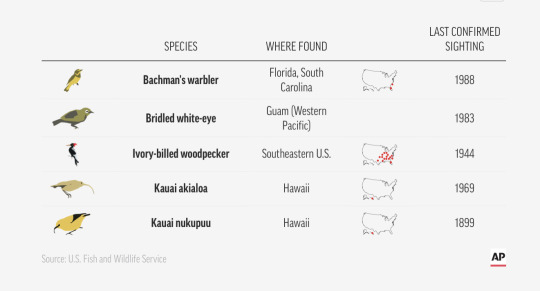
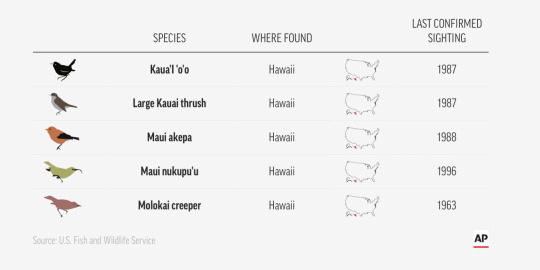
The factors behind the disappearances vary: too much development, water pollution, logging, competition from invasive species, birds killed for feathers and animals captured by private collectors. In all cases, however, humans were the ultimate cause.
Another thing the 23 newly extinct species share: All were thought to have at least a slim chance of survival when added to the endangered-species list beginning in the 1960s. Only 11 species previously have been removed because of extinction in the almost half-century since the Endangered Species Act was signed into law. Wednesday’s announcement kicks off a three-month comment period before the species’ grim status change becomes final.
Around the globe, some 902 species have been documented as extinct. The actual number is thought to be much higher because some were never formally identified, and many scientists warn that Earth is in an “extinction crisis,” with flora and fauna disappearing at 1,000 times the historical rate.
It’s possible one or more of the 23 species included in Wednesday’s announcement could reappear, several scientists said.
A leading figure in the hunt for the ivory-billed woodpecker said it was premature to call off the effort, after millions of dollars spent on searches and habitat preservation efforts.
This undated still image taken from video and provided by the Cornell Lab of Ornithology shows an ivory-billed woodpecker. The U.S. government is declaring the ivory-billed woodpecker and 22 more birds, fish and other species extinct. (Cornell Lab of Ornithology via AP)
“Little is gained and much is lost” with an extinction declaration, said Cornell University bird biologist John Fitzpatrick, lead author of a 2005 study that claimed the woodpecker had been rediscovered in eastern Arkansas.
“A bird this iconic and this representative of the major old-growth forests of the Southeast — keeping it on the list of endangered species keeps attention on it, keeps states thinking about managing habitat on the off-chance it still exists,” he said.
The International Union for Conservation of Nature, a Switzerland-based group that tracks extinctions globally, is not putting the ivory-billed woodpecker into its extinction column because it’s possible the birds still exist in Cuba, said the group’s Craig Hilton-Taylor.
Hilton-Taylor said there can be unintended but damaging consequences if extinction is declared prematurely. “Suddenly the [conservation] money is no longer there, and then suddenly you do drive it to extinction because you stop investing in it,” he said.

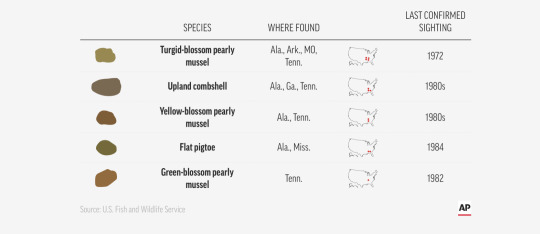
A warming climate means less Arctic ice and less opportunity for polar bears to hunt. A new study predicts that climate change could cause as many as one in six species to become extinct.
But wildlife officials said in an analysis released Wednesday that there have been no definitive sightings of the woodpecker since 1944 and “there is no objective evidence” of its continued existence.
U.S. officials said the extinctions declaration was driven by a desire to clear a backlog of recommended status changes for species that had not been acted upon for years. They said it would free up resources for on-the-ground conservation efforts for species that still have a chance of recovery.
What’s lost when those efforts fail are creatures often uniquely adapted to their environments. Freshwater mussel species like the ones the government says have gone extinct reproduce by attracting fish with a lure-like appendage, then sending out a cloud of larvae that attach to gills of fish until they’ve grown enough to drop off and live on their own.
The odds are slim against any mussel surviving into adulthood — a one-in-a-million chance, according to Ford of the wildlife service — but those that do can live a century or longer.
Hawaii has the most species on the extinction list: eight woodland birds and one plant. That’s in part because the islands have so many plants and animals that many have extremely small ranges and can blink out quickly.
The most recent to go extinct was the po’ouli, a type of bird known as a honeycreeper that was discovered in 1973.
By the late 1990s just three remained, a male and two females. After failures to get them to mate in the wild, the male was captured for potential breeding and died in 2004. The two females were never seen again.
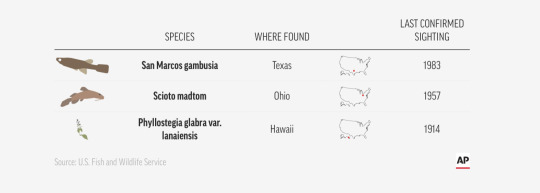
The fate of Hawaii’s birds helped push Duke University extinction expert Stuart Pimm into his field. Despite the grim nature of the government’s proposal to move more species into the extinct column, Pimm said the toll would probably have been much higher without the Endangered Species Act.
“It’s a shame we didn’t get to those species in time, but when we do, we are usually able to save species,” he said.
Since 1975, 54 species have left the endangered list after recovering, including the bald eagle, brown pelican and most humpback whales.
Climate change is making species recovery harder, bringing drought, floods, wildfires and temperature swings that compound the threats already facing the species.
How they are saved is also changing. No longer is the focus on individual species, let alone individual birds. Officials say the broader goal now is to preserve their habitat, which boosts species of all types that live there.
“I hope we’re up to the challenge,” said biologist Michelle Bogardus with the wildlife service in Hawaii. “We don’t have the resources to prevent extinctions unilaterally. We have to think proactively about ecosystem health and how do we maintain it, given all these threats.”
0 notes
Text
Dynasty App OTO
Dynasty App OTO Link Details
The first thing you need to do before going on any Dynasty App OTO is getting the front end. Click the below link to get the front-end offer first. Then you will be redirected to all the Dynasty App OTO pages one by one.
VISIT THE MAIN PAGE
What Is Dynasty App?
One button… to activate automated online shops that flood us daily with $1,000-2,000 payments. We use weird products that sell like hotcakes. You don’t even need to store the products. We ship everything for you.
You can activate your first super-store in 3 easy steps… Step #1: activate your store dynasty allows you to create a professional-looking, flexible, and customizable store using DFY templates. * note that you don’t need to manage inventory. * Step #2: add products to the store dynasty allows you to add hundreds of ready-to-profit products in under a minute… * Note: 1-click dynasty lets your store appear in front of as many buyers as you like on as many viral platforms
Once the stores are set up, they can be forgotten about… but still make a profit. They run on 100% autopilot… so once they’re done, we can let them go… and still earn autopilot earnings. This is the best thing about it all.
This is the best part about it all. We’re making a profit from the online shop craze without shipping products, having our own products, storing products, or all the other hassles that usually come with running an online business. Because we do things differently, people love dynasty.
Online super-stores are the secret to the trillion-dollar market. Instead of shopping in physical stores, online shopping is becoming more popular. This trend has been increasing since before the introduction of covid-19… but it sure has accelerated the process… To prove my point, $4.8 trillion was spent online… 1.92 billion people purchased goods online… 96% made purchases online… online shopping is undoubtedly the king in 2021…
It’s the largest wealth transfer in modern human history. The world has been changed by the pandemic… You’ve probably seen empty shopping malls, empty offices buildings, empty parking lots, and closed businesses.
Did you know that he is almost worth the entire new Zealand country? New Zealand’s GDP is $204 billion… And jeff is worth $199.7 Billion USD… That’s a lot of cheese! His wealth is mainly due to amazon… It’s an “online superstoreâ€, which made billions even during the pandemic… And Jeff isn’t the only one who has benefited…
Online shopping has created tens of thousands more millionaires and billionaires. These are people just like you… they come from modest backgrounds, yet have managed to become millionaires… or even billionaires…
It’s great! So why don’t we all do it? It’s easy to see why. There are many obstacles that you have to overcome. You need three things to be successful: A unique product, an easy way to sell it, and a way to make people trust your website. This can require months of research, thousands of dollars, and shipping, hosting, domain names, customer support, labeling… These are the main obstacles that prevent 99% of people from opening their own online shop.
Don’t worry! They have a solution for you… don’t own a website? You don’t have traffic/visitors? No problem… You don’t want anything shipped? No problem… You don’t own a domain. No problem… You don’t have products? No problem… You don’t have any experience? We have something out of the ordinary… It’s unlike anything else you’ve ever seen… It allows us to…
You will receive $1,000-$2,000 payments every month, just like clockwork. This is so powerful it should be illegal… however, it’s 100% legal… we get $1,000-$2,000 directly to our bank account: and here’s the thing I want to explain… 100% of our earnings are ours because we have almost zero expenses… OK, I do pay $10 per month for hosting. However… But anyway… Taxes are the only expense that we can avoid.
My online “superstores†bring thousands of buyers to me! Many are fighting for profit, but struggling to get the traffic they need. I have tried various methods such as Facebook ads, google ads… and display/banner advertisements.
But, I don’t have that much to worry about. Getting traffic is easy for me. My online stores generate free traffic by tapping into 9 viral resources that no one else is using… it’s all done for me in the background. It’s all so complicated that I don’t even know how it works. I hired a group of geeky, super-smart people to help me understand.
You can now grab Dynasty App from Venkata Ramana at an early bird price. Let’s choose the most suitable options before this offer ends!
Front-end: Dynasty App from Venkata Ramana ($17).
This is the shortcut to instant success. Dynasty is your shortcut to instant success. We are making $1,000-2,000 per sale of wacky but lucrative products… and we don’t even have to ship anything or work hard to get traffic.
Dynasty does the heavy lifting.
Dynasty Unlimited – OTO 1: (Price: $37)
Dynasty allows you to create unlimited online shops instead of only 5. All limitations are also removed.
Dynasty Done For You – OTO 2: (Price: $197)
We will help you set up your super-store online so that it can start making $1,000 per month.
Dynasty 1 hour Profits – OTO3: (Price $67)
You don’t want to wait for results for 1 week. Then don’t! This upgrade will speed up your progress so that you can make a profit in less than an hour.
Dynasty limitless traffic – OTO 4 : (Price $147)
You will be able to tap into my million visitor source and send 500-1000 targeted visitors daily to your online store…
Dynasty Diamond Edition OTO 5: (Price $97)
You can clone 12 more of my online shops that generate predictable income each day.
Dynasty Reseller OTO 6: (Price $197)
This will enable you to sell Dynasty and earn 100% commission for the entire funnel.
Dynasty App Features
You have access to a library of thousands upon thousands of RSS feeds that you can use to extract content for any niche.
An advanced spinning module transforms any content into a 100% unique form.
All spun content can be read by humans.
There are many auto-blogging settings that you can choose from to display your content the way you want.
AUTOMATIC image replacement to insert unique images into your posts.
Google Safe with Huge Results.
Our fully automated spinning system can be used to get you up and running in just minutes.
You can define your own synomyms or protected words for spinning.
Optional source attribution options (100% white hat use)
Professional site designed that is fully mobile-responsive.
All major providers have an integrated autoresponder integration.
Fully Automated: From the moment that you activate the theme, your site will begin ranking higher on Google
100% Original Content: There is no need to make any new content!
Our theme installation is simple and easy to use.
Works in ANY Niche: We offer access to thousands of content sources that you can use.
Fully Featured Premium WordPress Template: All the design, layout, and customization options that you would expect from a premium theme.
“DFY†On-Site SEO Mobile Optimization: All your on-site SEO and optimization are taken care of.
Create Content Visitors Love: Fully automated content that is human-readable and high-quality will help you get the content you want.
Unique “Image Spinning†Technology Included: You get unique IMAGES for your site content too!
Unlimited License: You can have many sites producing their own content, ranking themselves on FULL AUTOPILOT.
Dynasty App Demo
Tags: Dynasty App OTO | Dynasty App OTOs | OTO Feed | OTOFeed.com | Learn more: https://otofeed.com/
from https://otofeed.com/dynasty-app-oto/
from https://otofeed.weebly.com/blog/dynasty-app-oto from https://josephglover0.blogspot.com/2021/09/dynasty-app-oto.html
0 notes
Text
The ‘PC Master Race’ Still Sucks
On September 13, 2018, The Verge published a video guide for building a PC. Hosted by writer Stefan Etienne, the video was only 10 minutes long, and included a shocking amount of errors in that short time, some of which could ruin a computer.
The video instructed viewers to install components in the wrong order. When laying out his tools, Etienne referred to two zip ties as "tweezers." He applied way too much thermal paste to the CPU.
The response from the PC building and gaming community was immediate and ruthless. People started pointing out the numerous errors in the video on forums and social media. PC-oriented YouTubers and Twitch streamers made reaction videos, analyzing and mocking Etienne's many errors. While the written version of the guide is still up on the Verge, the publication eventually took down the video.
Today, Etienne will readily admit every error in the video, and has recently gone on the massively popular PC YouTube channel Linus Tech Tips to talk about the ordeal, and build a new PC with the eponymous Linus in an attempt at redemption.
The video aims to be a capstone for the whole affair. With Linus's blessing, Etienne has served his sentence of terrible internet virality. He made a mistake online, was run out of the PC community he considered himself a part of, and now that he's been thoroughly punished, he is ready to continue making the kind of content he'd been making for years before the infamous video derailed him.
It's a familiar cycle for online infamy, but allowing the Verge video debacle to simply end there ignores that the PC gaming community remains a largely unchecked haven for assholes. The clearest example of the worst aspects of this community is that, in addition to being mocked for his mistakes, Etienne said that he also received threats of violence, and that some people used racist slurs against him and the Verge editor in chief Nilay Patel.
"You put a couple screws in wrong, and you're a [n-word] now?" Etienne told me in an interview. "Nah, no, no, no, that's not how it works, bro."
That racial slurs would come out of a community that still jokingly defines itself with a reference to Nazi ideology—on Reddit the "PC Master Race" community has more than 5 million members—is not a surprise. In 2015, PC Gamer, a publication that caters to this community, encouraged readers to reject this term because of its racist connotations.
In 2016, I had my own brush with this side of the PC gaming community, after I published an article saying that getting into PC gaming is still way too hard. I've spent almost 20 years writing and editing online, sometimes covering criminals and actual neo-Nazis, and have seen plenty of readers respond with very angry, sometimes anti-Semitic comments. But the only time an editor ever checked in with me to see if I was doing okay because of the fallout of an article was after I said that installing an all-in-one CPU water cooler is not super easy. That's how big and vicious the response was.
My argument was and remains that while a PC is the best way to play games, it can be quite difficult to get into because of a high upfront cost; difficulties in shopping for the right build for the right budget; and the actual process of building the PC, which requires significant time and effort if it goes well, and can be frustrating and costly if anything goes wrong.
I've recently upgraded my GPU to an Nvidia GeForce RTX 3080, and, after months of diagnosing a recurring problem, upgraded my failing CPU to an AMD Ryzen 9 5900X, which required a new motherboard. While I was at it, I also replaced (on Linus's recommendation) my all-in-one water cooler with a Noctua heatsink and fan CPU cooler.
The size of these new components made installing them even harder. My Gigabyte-manufactured 3080 is over a foot long, and the Noctua cooler is so large it almost touches the far end of my large PC case. I had to move my SSD and remove an HDD tray rack entirely to make room for the GPU, which barely fits in the case. The CPU cooler is now so large that, as far as I can tell, I have to remove it in order to reach the RAM in case I want to upgrade it, which would mean reapplying the thermal paste and reinstalling the cooler. If I make a mistake during this process and damage a part, it could cost hundreds of dollars, and I might not even be able to get a replacement because there's a global shortage of parts.
It all worked out, but building a PC can be stressful depending on your budget and level of experience, and as Linus pointed out in his video with Etienne, doing any of this in the context of a video shoot, where there's limited time and things have to be performed for the camera, makes it much more difficult. According to Etienne, this is a big reason why the Verge video went so wrong.
Etienne told me the video shoot started at noon on a Friday, but that the shoot began with around three hours of photographing every single component, inside and outside the box. At around 3 p.m., he began the actual building process by unboxing the components on camera. As the process went on, prolonged by the fact that the camera had to capture it from several angles, Etienne and the video crew were getting close to 5 p.m. on a Friday, and the crew was itching to start the weekend.
"They start talking about what they want to do that evening, because it's Friday, which, hey, like we're all human, it's a Friday, we want to leave work," Etienne told me. "But it's 3 p.m. Right? You're not leaving anytime soon, the shoot just started."
"The Verge has always had zero tolerance for vile, bad-faith harassment campaigns against reporters, and this situation is no different," Patel told Motherboard in a statement. "You can read the editors’ note that Verge leadership posted in support of Verge writer Sarah Jeong in August 2018, and my own tweet below denouncing internet harassment, specifically addressing the PC build video. In addition to public support from editorial, Vox Media provides security support to ensure the safety and well-being of any staff members experiencing harassment."
Patel and Vox Media, which owns the Verge, did not respond to a specific question about how long Etienne had for the shoot.
The kinds of pressures Etienne describes are entirely familiar to me from Motherboard's own video productions. We've published two similar videos, one about building an Ethereum mining rig, and another about upgrading RAM on a 2017 iMac. It involves much more than just turning a camera on and doing the thing. There's a studio space that is booked ahead for a specific period of time. There are lighting and sound considerations which are different for every angle. If you fumble, you have to do it over again. PC enthusiasts often say that building a PC is just like playing with Lego, but imagine installing a CPU heatsink backplate in a cramped PC case while it's facing away from you and towards a camera, and while the clock is ticking.
"Members of [the crew that shot the video] came back to me personally after to literally walk me outside and apologize to me and say 'I didn't know building a computer was so hard,'" Etienne said. "It's not a quantum computer, but it's not Lego."
"That's one of the reasons I didn't get personal about what went up in that video," Linus said in his video with Etienne. "To me it looked more like a systemic problem. Someone, especially who has never done something before on camera, should have an experienced supervisor making sure that they don't say or do anything dumb, because it happens. That's the role that I'm playing here that was clearly completely absent at the Verge. How the fuck did that video ever get uploaded?"
Etienne said that after the incident that having that kind of supervision during shoots did become policy at the Verge after the PC video.
“Any time we issue a correction or in rare cases take down published material we try to learn from it and prevent similar things from happening in the future," Patel said.
One mistake Etienne makes in the Verge video is using the wrong screws to mount the motherboard to the case. As Linus points out in the video with Etienne, when you're building a PC, you'll have multiple types of screws with the same threading that look similar, but have different purposes. Here, for example, is an M3 button head screw and an M3 countersunk screw, side-by-side. One would be used to mount the motherboard while the other would be used for installing an SSD into a tray:

Image: Linus Tech Tips
This is the kind of minutiae a user has to internalize in order to build their own PC correctly, and it's a big reason why people cling to their game consoles and Macs even though a PC is so much better than both. It might not seem like a big difference, but using the wrong screw, especially a screw that is too long, can permanently damage the motherboard or other expensive components.
This is basically what I said in my 2016 article, and I still get angry emails about it today. My favorite reaction came from Gamers Nexus, a PC YouTube channel (that I like!), which made a response video to the article to "defend the PC building culture." In it, Gamers Nexus editor in chief Steve Burke (again, big fan!) opens by mocking me for saying that I cut myself while building the PC and joking that "I bled for this fucking thing." Ten minutes later into the same video, Burke proceeds to cut himself while building a PC.
That some people reacted to Etienne's Verge video with harassment doesn't just make PC building inaccessible because it requires a basic familiarity with the technology. It allows a minority of bigoted idiots to lay claim to a fine hobby, and alienate everyone else. That some of the harassment is racist and misogynistic also turns the hobby into a space that's difficult to enter if you're anything but a white man.
Etienne told me that so far, the reaction to his video with Linus has been positive. It's the reaction we should have had from the start. Rather than punish and harass someone for making a mistake, the community should have reached out to help and bring more people in. Etienne said the video with Linus has invigorated him to make content again. Some people, he said, have sent messages to him and his girlfriend, apologizing for using slurs against them when the Verge video came out.
"Sometimes people are phony, they'll say they were sorry, when they were never sorry," Etienne said. "Or they'll say sorry, because they feel bad, and they want you to like them again. There's all types of angles. My thing with it is, I don't care. As long as the right content got out there."
The ‘PC Master Race’ Still Sucks syndicated from https://triviaqaweb.wordpress.com/feed/
0 notes
Text
Ventilating complaints about air standards
The world has finally accepted that the COVID-19 virus is spread on the air, and mainly indoors. So why haven’t ventilation standards been updated for buildings?
This article first appeared in Cosmos Weekly on 30 July 2021. For more stories like this, subscribe to Cosmos Weekly.
Australia is in the grips of another COVID-19 outbreak. This time, the highly transmissible Delta variant of SARS-CoV-2 has plunged many into lockdown and put the nation on high alert.
Epidemiologists say the Delta variant, which has spread to 104 countries and counting, may be about 90% more infectious than the original – Alpha – strain of SARS-CoV-2. But one thing remains the same: this virus is airborne. It spreads in the air we breathe. In lab studies, SARS-CoV-2 has been shown to linger in the air for up to 16 hours, carried aloft on microscopic particles called aerosols.
World-leading aerosol scientist Professor Lidia Morawska, of Queensland University of Technology (QUT), in Brisbane, says the latest outbreak has once again exposed the gaps in our hotel quarantine system and highlighted flaws in building design and ventilation systems – which should flush out contaminated air, without affecting other occupants, if designed correctly and operating well.
“Well over a year into the pandemic, there hasn’t seen any progress whatsoever [in Australia] to tackle this,” Morawska says. “No one mentions the word ventilation.”
The latest outbreak has once again exposed the gaps in our hotel quarantine system and highlighted flaws in building design and ventilation system.
Morawska is not alone in her frustration. Architects and building engineers are also calling for stronger recognition of respiratory viruses that spread via aerosols and improvements to ventilation in public spaces.
“We knew in July last year that SARS-CoV-2 was airborne,” says architect Geoff Hanmer, an adjunct professor of architecture at the University of Adelaide. “And yet it’s taken ISIAQ [the International Society of Indoor Air Quality and Climate] and the World Health Organization almost a year to admit that that’s the case.”
These experts’ exasperation is exacerbated because the engineering solutions to rid indoor spaces of airborne pathogens already exist – they just need to be installed or upgraded.
What needs to be done?
There are three key ingredients in the cocktail that is infection risk, Morawska explains. The first is the concentration of airborne particles that are emitted when an infected person talks, sings, coughs or sneezes. Second, a lack of ventilation, which lets aerosols linger in the air. And thirdly, some exposure time for people to inhale the virus-laden particles.
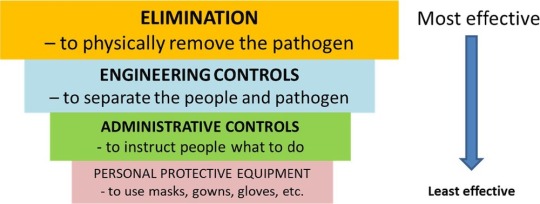
Traditional infection control pyramid adapted from the US Centers for Disease Control. Credit: Morawska et al/CDC/Environment International
Changing how buildings operate can address two out of those three factors. Improved ventilation increases airflow, diluting airborne particles; incorporating high-grade filtration systems can remove microscopic contaminants from the air.
However, the current standards for ventilating indoor public spaces (excluding hospitals) are not designed for infection control.
Public buildings from hospitals to schools and aged care facilities are “naturally” ventilated, meaning they rely on open windows to let fresh air in. They often have inadequate or poor ventilation, particularly in colder months.
“Very few countries have any regulations about indoor air quality. Infection transmission – which occurs mainly in indoor public spaces – is not specifically mentioned in any national regulations,” says Morawska.
“We must do something about the [building industry] standards.”
Hanmer says revising construction codes to improve ventilation standards to control for airborne infections would be a good start.
“But the problem is that new buildings are only a very small fraction of the total population of buildings,” he says.
Public buildings from hospitals to schools and aged care facilities are “naturally” ventilated, meaning they rely on open windows to let fresh air in. They often have inadequate or poor ventilation, particularly in colder months.
Many commercial buildings, such as shopping centres, hotels and universities, are also poorly ventilated, Hanmer says, because the performance of their mechanical ventilation systems – which pump in fresh air to replace stale indoor air – is too often substandard.
“It’s a bit of a lottery at the moment – certainly we need to get to a state where we’ve got better data and better regulation on air quality, generally,” says Hanmer, who recently surveyed the air quality in a number of public buildings.
“Clearly, the application of [national construction] codes in mechanically ventilated buildings hasn’t been as good as it should be.”
How can it be done?
Increasing ventilation rates to create greater airflow through rooms and buildings is one way to minimise infection risk indoors.
In 2009, WHO compiled 65 studies showing that poor ventilation is “associated with increased infection rates or outbreaks of airborne diseases”, concluding that “higher ventilation rates could decrease the risk of infection”.
But hard evidence linking improved ventilation with reduced infection rates directly is scarce. A 2019 study from the Taiwan Centres of Disease Control is a rare example. It found that increasing ventilation in stuffy university buildings controlled an outbreak of tuberculosis, an airborne bacterial disease. The outbreak, which lasted three years and involved 27 active cases and 1,665 contacts, was snuffed out after ventilation specialists reconfigured the building’s ventilation systems to improve airflow.

Portable air purifiers may help. Credit: Onurdongel/Getty
Fast forward to 2021, and both the WHO and US Centres for Disease Control and Prevention (CDC) now recommend that the total indoor air volume in healthcare facilities should be replaced with fresh outdoor air a minimum of 6 to 12 times per hour to prevent the spread of COVID-19.
Epidemiologist Mary-Louise McLaws, of UNSW Sydney, says this is the gold standard for ventilation for “hot zones” in hospitals – equivalent to 80 litres of air per second per person – and that these ventilation rates can be hard to achieve. In other settings, such as confined spaces and offices, airflow rates of 3 litres of air per second per person are needed, McLaws says.
While experts deliberate over exactly how much ventilation is needed to reduce infection rates, Morawska says there is no magic number because it depends on how the building is used.
This includes the number of people in each room (“The more sources, the higher the [required] ventilation rate,” she says) and their usual activities such as exercising, singing or talking loudly, all of which expel large amounts of viral particles.
Occupancy, though, can vary from one hour to the next, so ventilation systems need to be flexible. But ramping up ventilation is not just a matter of a simple flick of a switch; airflow direction and distribution are also important.

Engineering level controls to reduce the environmental risks for airborne transmission. Credit: Morawska et al/Environment International
Adding pathogen-proof filters to existing ventilation systems is not always possible either, if the airflow is too weak. Engineers also need to design ventilation systems with energy conservation in mind, Morawska says.
“It’s not just about increasing ventilation rates,” she says. We need smarter systems that remove the virus or any other contaminants but do not increase energy use.”
“We need to make sure that naturally ventilated buildings with high use have some fallback ventilation,” he says.
Demand-controlled systems could be used in schools to increase ventilation during predictably busy periods and dial airflow down when rooms are not in use. Another option is installing ventilation systems that detect rising levels of CO2 levels and kick in when air quality deteriorates, says Hanmer.
Ramping up ventilation is not just a matter of a simple flick of a switch; airflow direction and distribution are also important.
A fallback ventilated system comes into operation when the detected levels of CO2 in the air rise above about 800 parts per million, so it could reliably improve air quality, Hanmer says. Aged-care facilities would be the “absolute first priority” and schools a close second.
Building systems engineer Professor John Zhai, of the University of Colorado Boulder, suggests a simpler solution: portable air purifiers could be installed to filter air in crowded public spaces such as supermarket checkouts. These systems could be deployed quickly to reduce infection risk, provided they are the right size for the space.
Researchers are also designing smart systems that can detect mobile phone signals or use cameras (with image-processing algorithms) to determine when an indoor space gets too crowded and needs more ventilation, adjusting flow rates accordingly.
What would it cost?
Few economic analyses have been done to estimate the cost of improving ventilation because no one has been asking the question, says Morawska. However, available estimates suggest that necessary investments in building systems may be less than 1% of the construction cost of a typical building for new builds.
Hanmer estimates it would cost a few thousand dollars per room to install fallback ventilation systems in aged-care facilities. “I don’t think that’s an unreasonable burden given the seriousness of the disease,” he says. “And it’s whole lot less than a lockdown in a major capital city.”
But on top of the price tag for installations and upgrades, Zhai says that building engineers also have to consider the energy costs of running souped-up ventilation systems. Installing high-grade filters capable of trapping and removing microscopic airborne particles means greater fan power is needed to push the air through the filter – and that uses more energy, he says.
Around 40% of the total electricity used in buildings already goes into powering ventilation fans and it would take tremendous amounts of energy to increase airflow rates to recommended levels, Zhai says: “To double the flow rate, you basically need eight times the energy use.
The cost of improving ventilation system would be far less than the billions of dollars spent each year on influenza and other respiratory diseases.
“It can work for most emergency situations. You can supply a lot of air for a short period of time, to reduce infection risk. But for regular times, it’s not economically wise to do that.”
Morawska says, however, that the cost of improving ventilation system would be far less than the billions of dollars spent each year on influenza and other respiratory diseases. It could also help curb the costs of COVID-19, which currently has a global financial toll to the tune of $1 trillion each month.
But if countries continue to dismiss the airborne transmission of COVID-19 and other infectious diseases, as they have done for decades, then we will suffer the cost of this denial, Morawska says.
“Unless we start putting steps in place now to fix things on the longer term, once the pandemic passes – and it will eventually pass – no one will want to do anything about this,” she says.
“We’ll be left in exactly in the same situation when the next pandemic comes and still dealing with respiratory infections like the cold and flu.”
This article first appeared in Cosmos Weekly on 30 July 2021. To see more in-depth stories like this, subscribe today and get access to our weekly e-publication, plus access to all back issues of Cosmos Weekly.
Subscribe now
Ventilating complaints about air standards published first on https://triviaqaweb.weebly.com/
0 notes